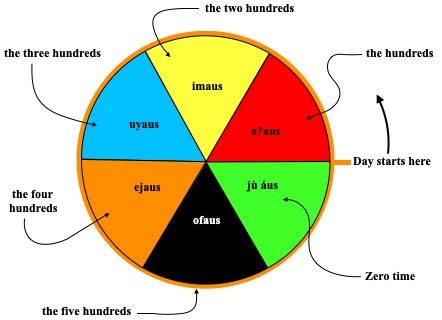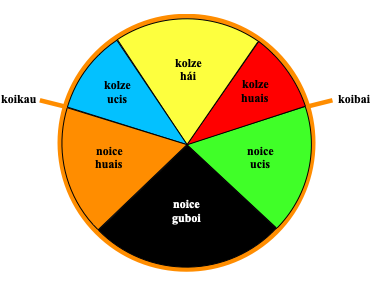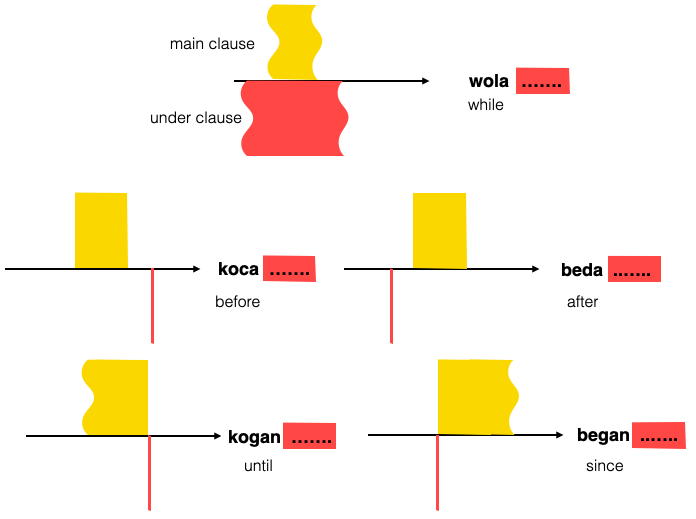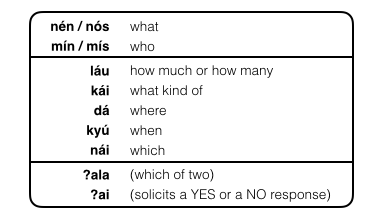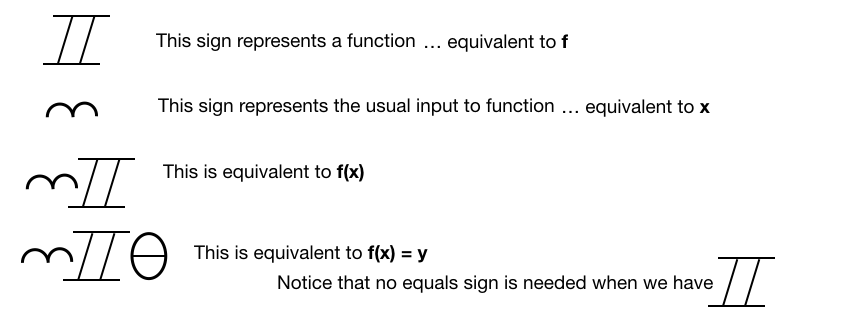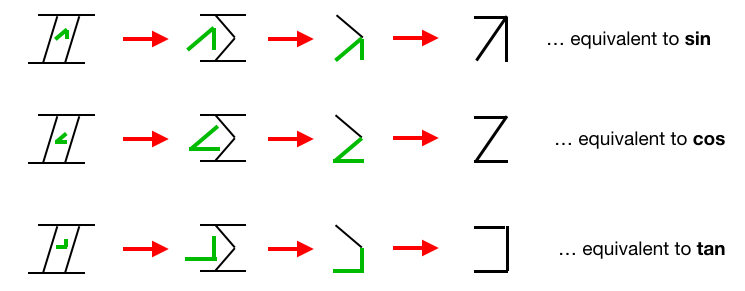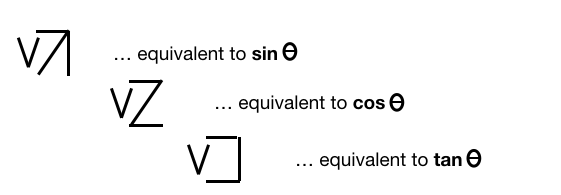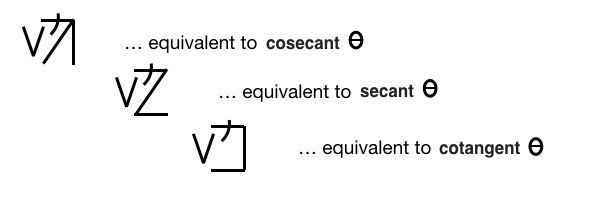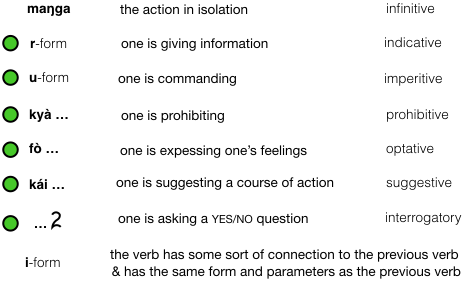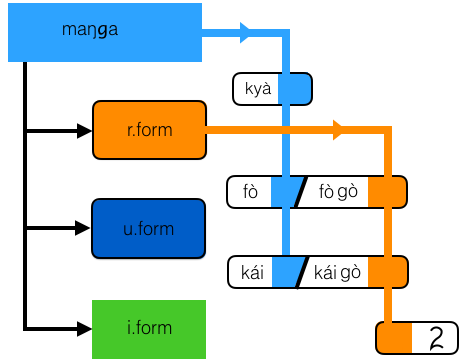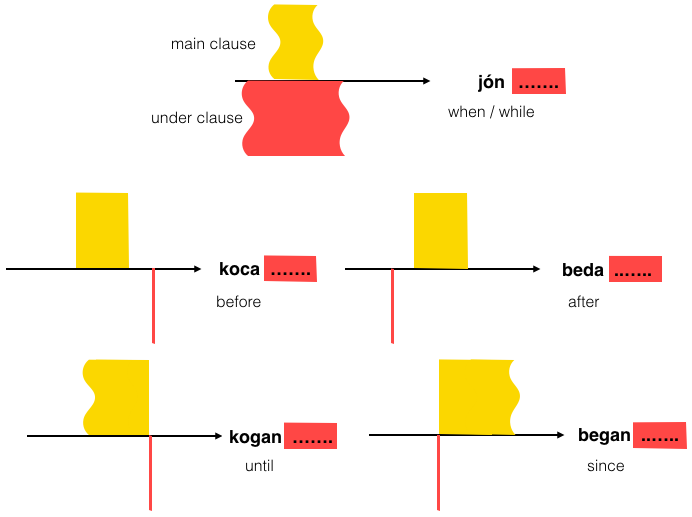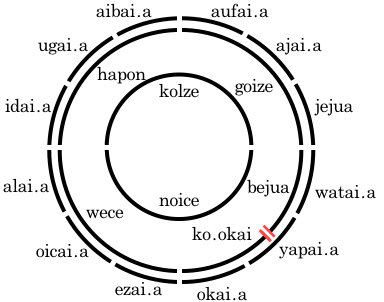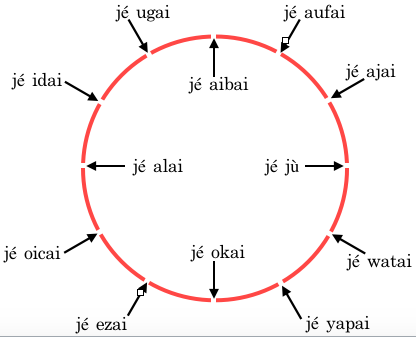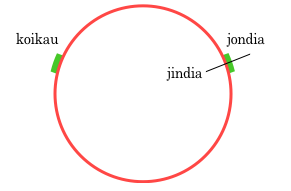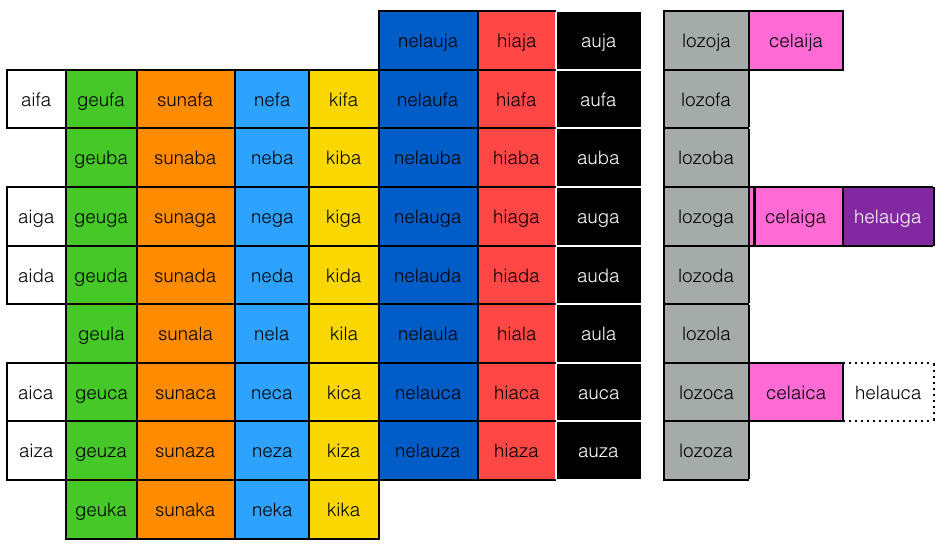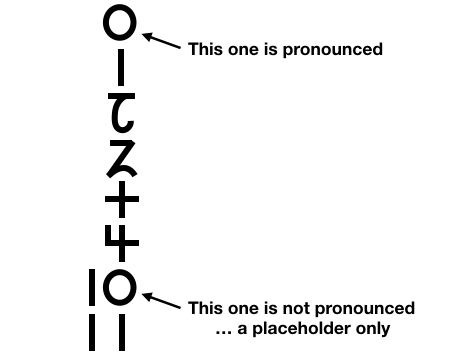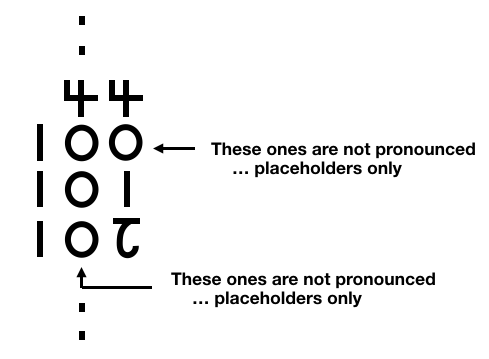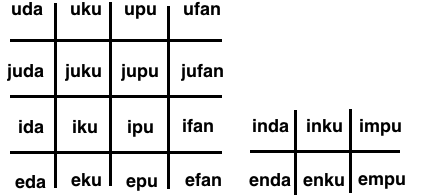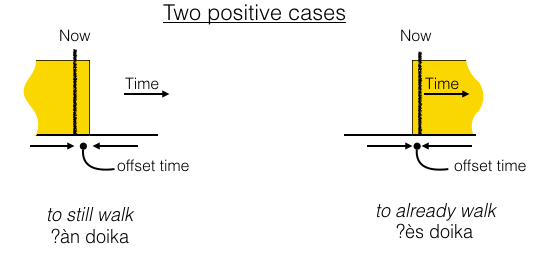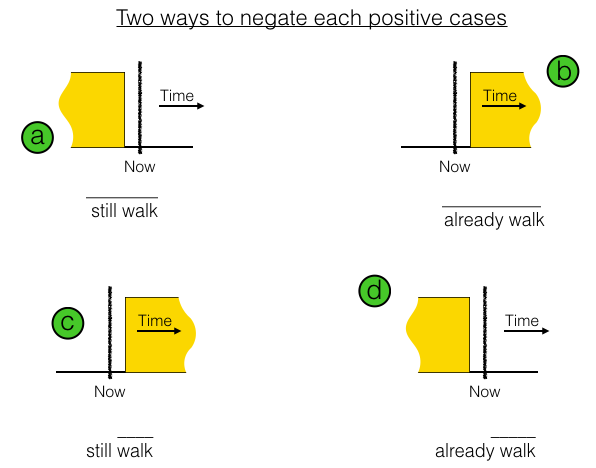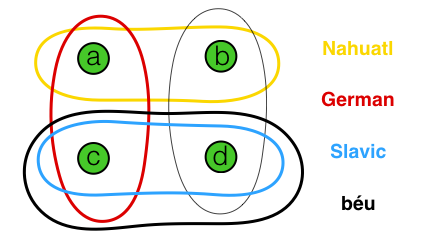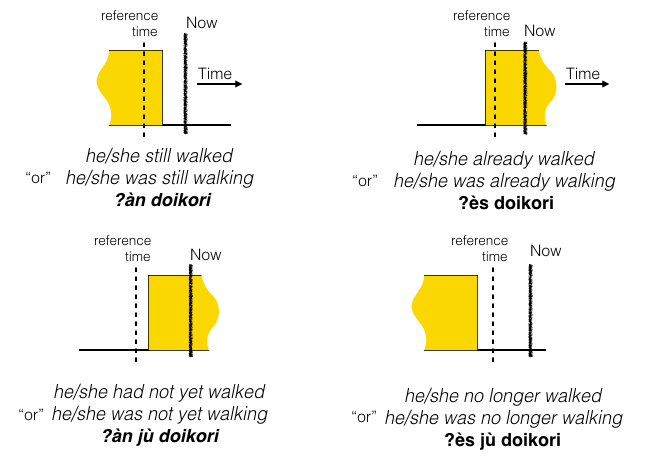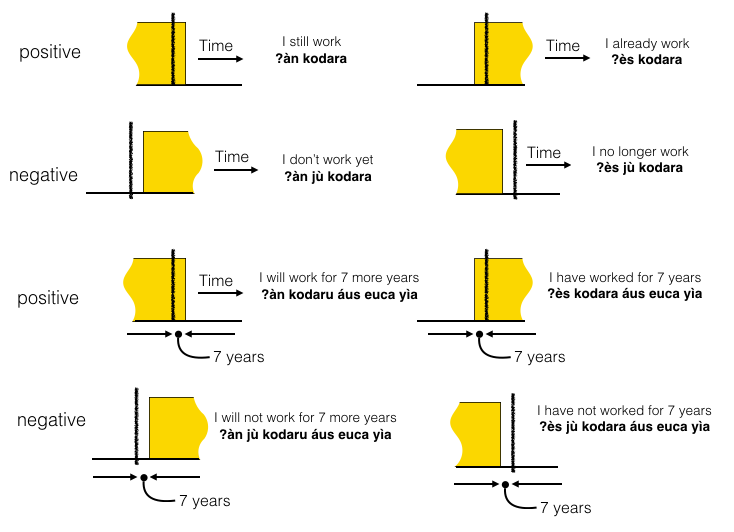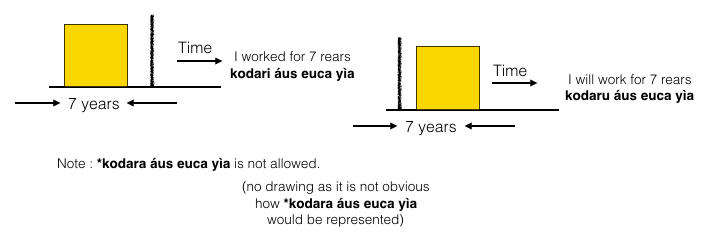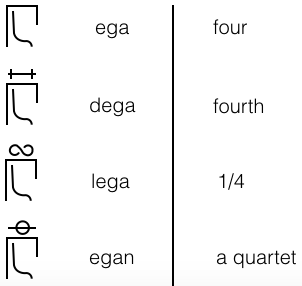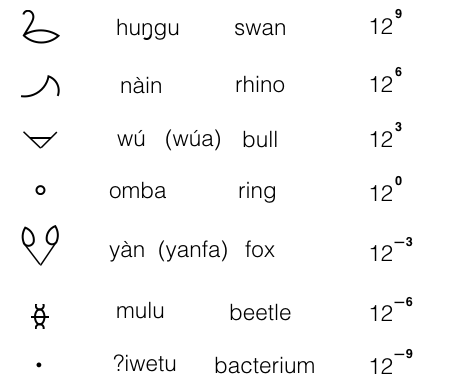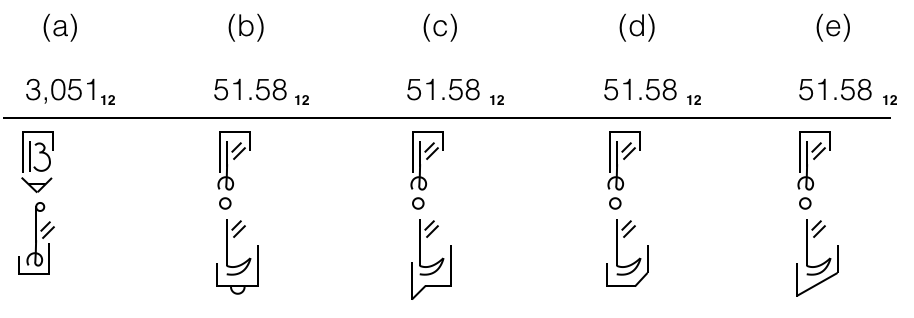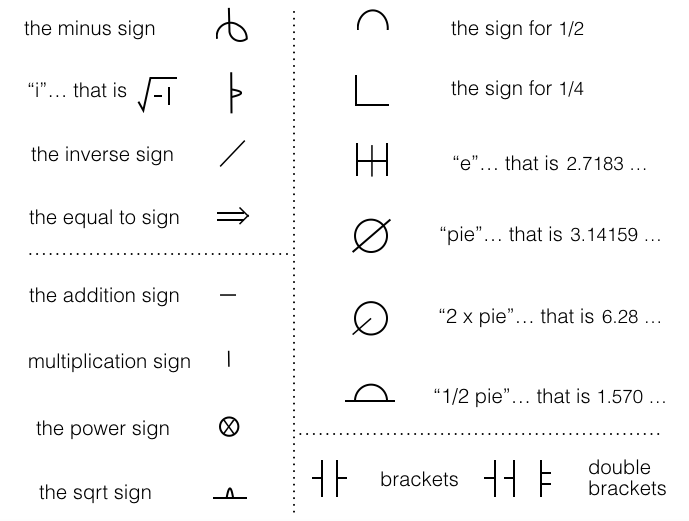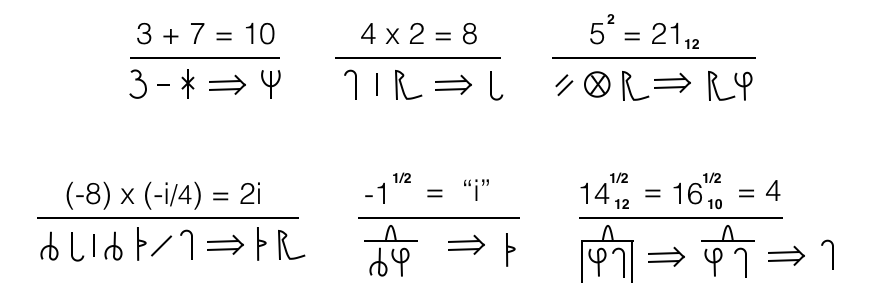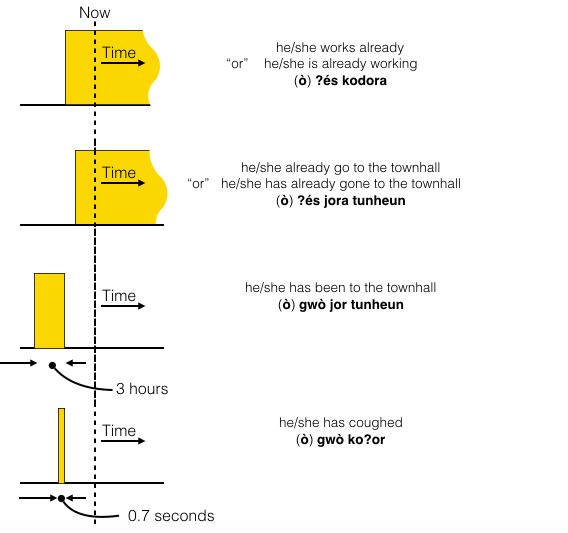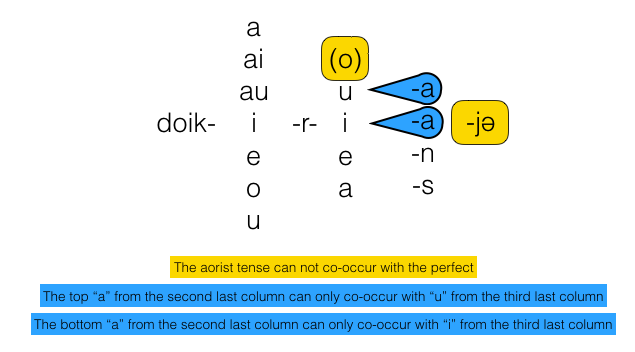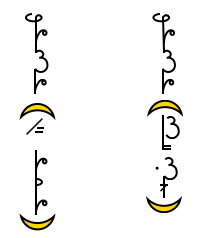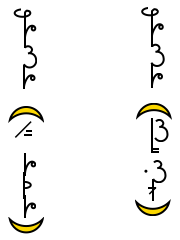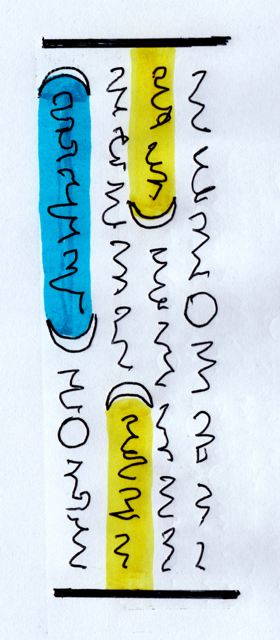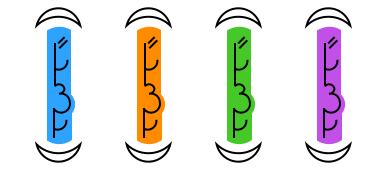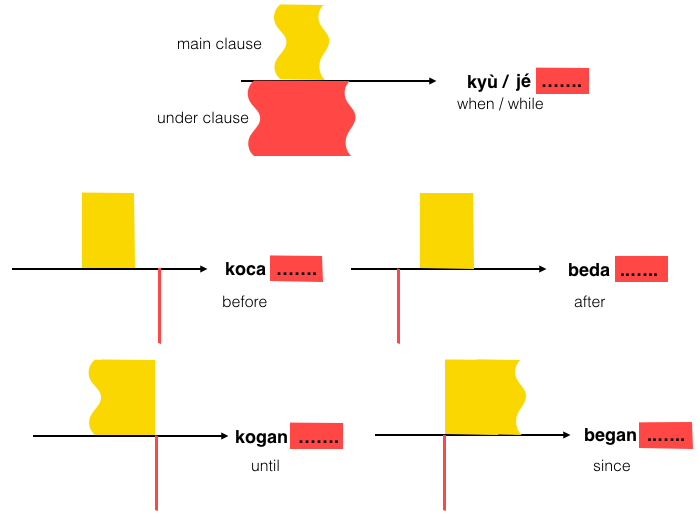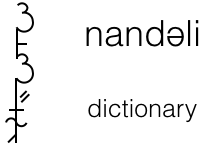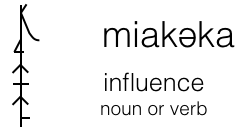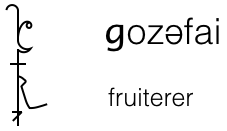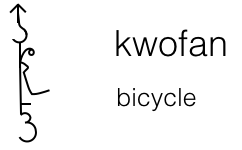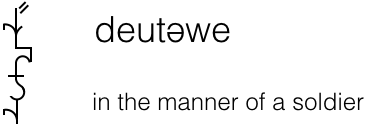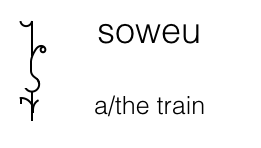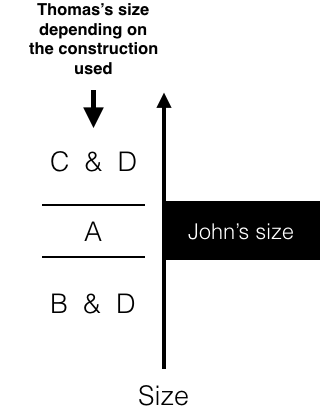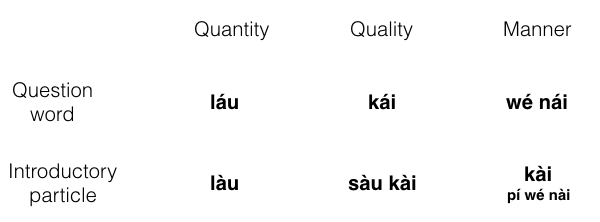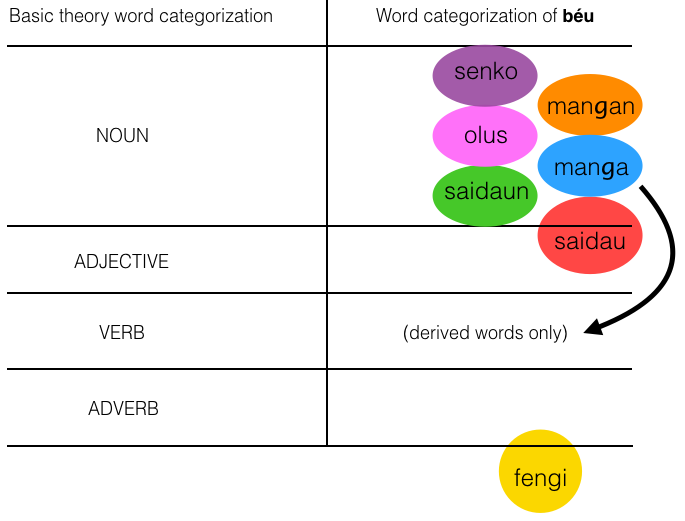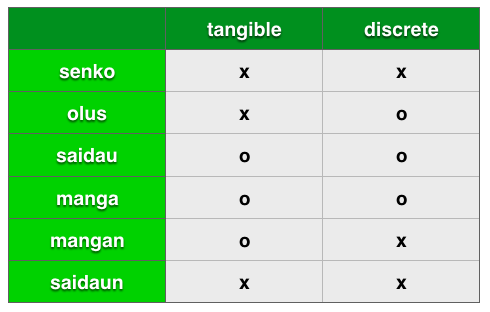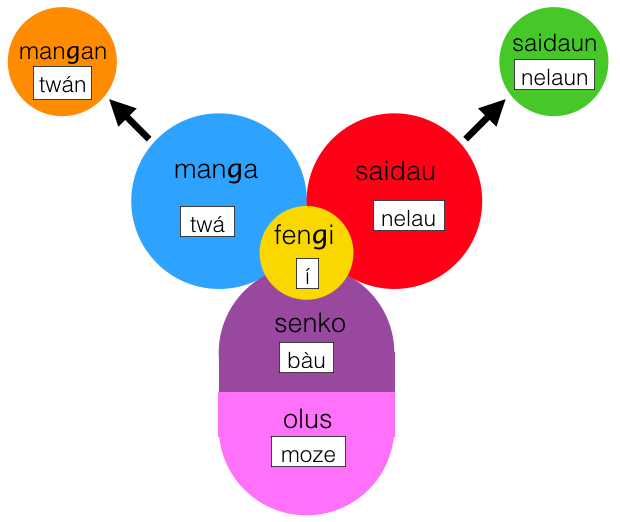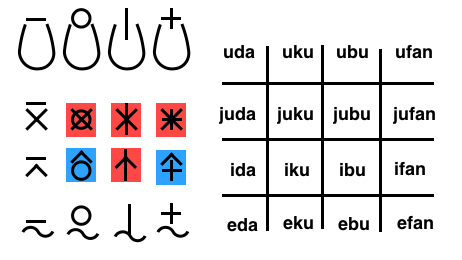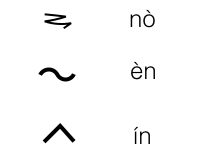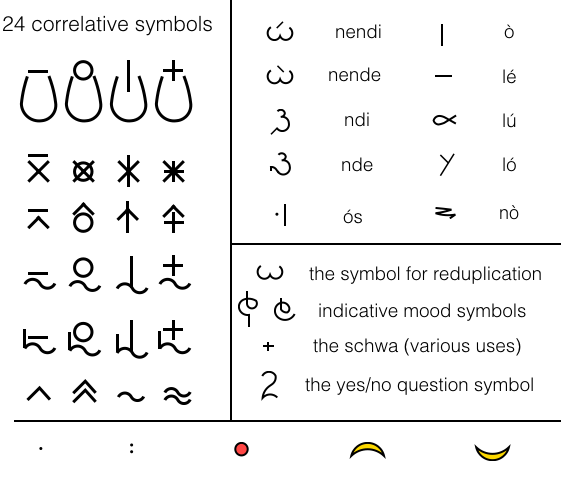Béu : Discarded Stuff
Contents
- 1 ... The time of day
- 2 ... Ways to join clauses timewise
- 3 ..... Questions questions
- 4 ... The particle gú
- 5 ... Trigonometry
- 6 ... Other Verbal Moods
- 7 ... Ways to join clauses timewise
- 8 ..... Two prefixes
- 9 ... Telling the time
- 10 ..... The Calendar
- 11 ... All the numbers
- 12 ... 16 common words in a neat 4x4 matrix
- 13 ... Classifiers
- 14 ... Happenings overlapping
- 15 ... Non-zero reference time
- 16 ... When the overlap is specified
- 17 ... Restrictions
- 18 ..... Numbers
- 19 ... Ordinal numbers
- 20 ... Numbers ... (the extended set)
- 21 ... Numbers ... (free form + plus mathematical notation)
- 22 ..... The perfect versus "already"
- 23 ..... IA and UA
- 24 ... Two old participle
- 25 ... Old perfect
- 26 ... Old, old stuff
- 27 ... This material goes back a long way ... to the time I was thinking of making the passive with an aw infix
- 28 ... Kyù and jé discarded
- 29 ... Word building
- 30 ... The particles làu, kài, "wé nài" and ?à ... this is quite complicated
- 31 ... The 7 types versus basic types
- 32 ..... The 7 types of word
- 33 ..... Correlatives
- 34 ..... Some anaphora rubbish
- 35 ..... Old morning/afternoon
- 36 ..... Index
... The time of day
..
The 24 hour period has six major divisions. Starting at six in the morning (in our system).
Two things are a bit unusual here ...
1) Zero time is the last period of the day.
2) Literally "the two hundreds" (for example) would be imau.a, so imaus is a bit idiomatic.
..
jù aús means "zero period" [ it is hard to decide which is the "head" in this expression ... no matter. The important bit is that all six periods rhyme ;-) ]
As for the others, well a bit of a dispute there, some think a?aus is a contraction of a?au aús, some think it is a?au with the adverbial marker -s. Again ...no matter.
OK ... we have divided the day into 4 hour segments. We can further divide each of these major time periods into six 40 minute intervals. By way of example, lets sub-divide the evening.
..
| 18:00 => 18:40 | ejaus jù aús .... | evening, zero period |
| 18:40 => 19:20 | ejaus a?ai.a | evening, the tens |
| 19:20 => 20:00 | ejaus imai.a | evening, the twenties |
| 20:00 => 20:40 | ejaus uyai.a | evening, the thirties |
| 20:40 => 21:20 | ejaus ejai.a | evening, the forties |
| 21:20 => 22:00 | ejaus ofai.a | evening, the fifties |
..
Note : 02:00 => 02:40 is called jù aús jù aús. I guess if it was used a lot it would get eroded to jù jù aús but I don't see this period of time being talk about a lot..
..
Now aús relates to a period of time. jé (meaning "at" but w.r.t. time) relates to an instant of time. It is logical to think that if we keep dividing up a period of time we would approach to an instant in time. A further division by 6 gives us 6 minutes + 40 seconds. In béu culture this is considered an instant ... like if you arranged to meet somebody, the meeting would only be specified to the nearest 6 minutes + 40 seconds (I guess it is quite a relaxed culture).
By way of example, lets sub-divide "evening, the forties".
..
| 20:40:00 => 20:46:40 .... | jé jà jà jù | |
| 20:46:40 => 20:53:20 | jé jà jà ?à | |
| 20:53:20 => 21:00:00 | jé jà jà mà | |
| 21:00:00 => 21:06:40 | jé jà jà yà | |
| 21:06:40 => 21:13:20 | jé jà jà jà | |
| 21:13:20 => 21:20:00 | jé jà jà fà |
..
When these special short number forms are used, you always have three of them and they always follow jé
..
Every instant that end if jù has an alternative form. For example jé jà jà jù can also be expressed as ejaus jé ejai
There are two fixed times that have a special name. Midday which is when imaus imai.a changes to imaus uyai.a is called haimo. Midnight which is when ofaus imai.a changes to ofaus uyai.a is called yenu
Dawn is called koibai and dusk is called koikau. These of course depend on the time of year and the latitude. koikau has a religious significance.
koikau => koibai is called noice "night" : koibai => koikau is called kolze "day time"
A system of rough time keeping is based noice and kolze. hái means "high" and guboi "deep". hua.is means "early" and ucia "late".
The above example represents a winters day.
..
There is a subsiduary method of time keeping that is common. It is based on the local time at Mangareva. Mangareva is a small pacific island : 23 06 34 S : 134 57 57 W
When you are giving Mangareva time you simply put tekan "world" in front of the time expression. tekan time is basically GMT -9 hours.
..
Every town has a clocktower and the clocktower has 4 faces, which are aligned with the cardinal directions. The street pattern is also so aligned : that is the four biggest streets radiate out from the clock in the cardinal directions.
..
...................... The East Face ............................. The North Face .............................. The West Face ............................... The South Face
..
All three hands move anti-clockwise. The big black hand sweeps out one revolution every 24 hours and the middle hand sweeps out a revolution every 4 hours. The small hand every 40 minutes.
All of the hands have step-motion.
The black hand once every four hours ... 60 degrees at a time.
The middle hand moves once every 6 2/3 minutes ... it moves 10 degrees.
The small hand moves once every 33 1/3 seconds ... it moves 5 degrees.
The clocks usually have a sound system associated with them. This sound systems depend on the local area.
A common sub-system is for sound1 everytime the black hand moves.
Sometimes there are sound2 midway between the black hand moving.
And there are other systems. Often it is decided that the sounds can be done away with or partially done away with at night.
Would a sound3 everytime time the middle hand moved be helpful ... perhaps just stress causing ??
The clocktower is surmounted by a green conic roof (actually not really conic ... the roof slope decreases as you get nearer the bottom). Lighting from under the roof could be provided for each face. Either that or the faces could be illuminated from within at night. The faces are not exactly vertical but the top slightly overhangs the bottom.
There is never any numbering on the face.
..
[One possible system ... Every 2 of our hours the clock makes a deep "boing" which reverberates for some time. Also from 6 in the morning to 6 at night, the clock emits a "boing" every 30 of our minutes. The first "boing" has no accompaniment. However the second "boing" is followed (well actually when the "boing" is only .67 % dissipated) by a "sharper" sound that dies down a lot quicker. Lets call this the "teen" sound. The third "boing" has 2 "teen"s 0.72 seconds apart. The fourth has 3 "teen"s. The fifth one is back to the single "boing" and so it continues through-out the daylight hours]
..
... Ways to join clauses timewise
..
In the previous sections we have seen how to give time information. However there is another way to give the time ... with respect to an evert or action.
We will cover six particles in this section which allow us to give time information with respect to an event ... wola koca beda kogan began and jindu.
..
wola* = "while" ( or "when")
koca = before
beda = after
kogan = until
began = since
jindu = as soon as
In a similar manner to English, they can either introduce a clause, a noun (that designates a time) or an infinitive phrase.
“After I ate breakfast”
“After the gold rush”
“After the eating of my breakfast”
The above are all time adverb phrases. A time adverb phrase is a dependent clause** (called an under clause in béu) ... shown in red below. The main clause is shown in yellow.
..
Tha arrow is the arrow of time*** ... with the past to the left (komo), and the future to the right (bene).
I have given events wavey borders to represent "not so well defined". So, for example, on the top diagram ... the main clause action could start before the under clause action ... it could also outlast the under clause action ... the important thing is that for a substantial amount of time, the two actions were going on at the same time.
In the bottom four examples I have made the under clause actions very short. This is for illustration purposes only. The under clause actions can actually have any length ... depend on the verb/situation.
Now these five examples show how two clauses can be joined in a timewise fashion. The béu rules are quite similar to English. That is ...
A) the under clause must be introduced with one of these 6 particles.
B) we can have main clause and then the under clause ... or the other way around.
Here are examples to illustrate the 5 examples above ...
..
1) wola = while, as, when
pás pintu saikaru wola gís pazba saikiru = "I will paint the door, while you paint the table"
wola gís pazba saikiru_pás pintu saikaru = "while you paint the table, I will paint the door"
wola saiko pazba_gís huʒiri = "while painting the table, you smoked" ........................... (this also can be expressed as ... pín saiko pazba_gís huʒiri)
..
2) koca = before
pazba saikaru koca pintu (saikaru) = "I will paint the table before (I will paint) the door"
koca pintu saikaru_pazba saikaru = "before I paint the door, I will paint the table"
koca saiko pintu_pás pazba saikaru = "before painting the door, I will paint the table"
..
3) beda = after
pintu saikaru beda pazba (saikaru) = "I will paint the door after (I will paint) the table"
beda pazba saikaru_pintu saikaru = "before I paint the door, I will paint the table"
beda saiko pazba_pás pintu saikaru = "after painting the table, I will paint the door"........................... (this also can be expressed as ... gwò saiko pazba_pás pintu saikaru)
..
If you wanted to emphasize that the first action will continue until the second action you would use ...
4) kogan = until
gís huʒiri kogan dare saiko pazba = "you smoked until I started to paint the table"
kogan dare saiko pazba_gís huʒiri = "until I started to paint the table, you smoked"
kogan día saiko pazba_gís huʒiri = "until starting to paint the table, you smoked"
..
If you wanted to emphasize that the first action has been continuing all the time since the second action you would use ...
5) began = since
gís ʔès huʒira began care saiko pazba = "you have smoked since I stopped painting the table"
| gí-s | ʔès | huʒ-i-r-a | began | c-a-r-e | saiko | pazba |
|---|---|---|---|---|---|---|
| you-ERG | already | smoke-2S-IND-PRES | since | stop-1S-IND-PAST | painting | table |
began care saiko pazba_gís huʒira = "since I stopped painting the table you have smoked"
began cùa saiko pazba_gís ʔès huʒira = "since stopping painting the table, you have smoked" ... [By the way ... began ìa saiko pazba_gís ʔès huʒira = "since finishing painting the table, you have smoked" ]
..
There is one added complication in the above scheme ... if the intersect time of the two actions is in the future, then jindu (<jín "a moment" + dù "exact") can be used instead of began.
..
..
* It is speculated that this comes from jwòi = "to pass through, to undergo, to bear, to endure, to stand" plus the pila?o là. jwoila => wola
..
** I guess I should say what is the difference between a main clause and an under clause. (I should read about what other linguists say about this some day). Take the sentences ...
(1) I will finish this drink before I go home. ......... (2) I will go home after I finish this drink.
In terms of pure logic these both mean exactly the same. Also the choice of whether a verb is in the main or the under clause says nothing about the speakers attidude towards that verb ... i.e. relish, disgust, foreboding, sadness etc. But is seems that the verb in the main clause is the target of the speakers determination/willpower/resolve whereas the verb in the underclause is the target of nothing. I guess you can say it is background material
..
*** The organization of the Chinese writting system seems to have affected the language itself. The primary writing direction was top_to_bottom so of course the calendar was written top_to_bottom as well. From that "above" got associated with "the past" and "below got associated with "the future".
午 wǔ "noon" : 上 shàng "above" : 下 xià "under" => 上午 shàngwǔ "morning" : 下午 xiàwǔ "afternoon"
A similar thing happened in béu. The practitioners of béu are above all engineers and the algebraic convention of having time along the horizontal axis has affected the language somewhat.
..
Addendum ... jín means an interval of time an order of magnitude shorter than jón. The particle jindu is derived from it.
The adverbs jondi and jindi are derived from the above. They both mean "now". jondi is the one usually used. jindi is used for emphasis (for example in a swiftly changing situation).
Also they give rise to the adverbs jonis "soon" and jinis "immediately".
..
"Inside the action"
..
pí means "in" and is used for any noun, even for a noun denoting a period of time. English tends to use "during" for a noun denoting a period of time. For example ... "during the pandemic of 2010". By using only pí with nouns, béu looses a bit of clarity. For example, does butwapi mean "in the battle" or "during the battle" ? But anyway ... there are ways to make yourself clear.
For clauses wola is used. Equivalent to "while" in English [interesting fact ... German "während" is equivalent to "while" AND "during"].
And pín is an aspect particle which must go before the verb. It can be with an active verb or with a verb base. In both cases it must immediately precede the verb.[See ch3 (three aspect particles)]
As "any intermingling that is appropriate for an active verb is also appropriate for an verb base", and a clause is just verb-plus-add-ons, wola can also appear with a verb base (see example (1).
..
..... Questions questions
..
English is quite typical of languages in general and has 8 question words ... "which", "what", "who", "whose", "where", "when", "how" and "why". *
..
..
... The particle gú
..
The particle gú is equivalent to "whether" in English. Perhaps derived from gò lú bù ... the g from gò, the high tone from lú and the u from bù.
This is something of a logical derivation. It could not come about by erosion of gò lú bù because these three elements are never contiguous ... more like gò "clause" lú bù
..
Not to be confused with gù which means "master".
..
gú lú bù => whether or mot => even if
..
... Trigonometry
..
Of course there is also a method to represent other functions. We use the same basic function symbol as before but an extra smaller symbol within the enclosed area.
The three trogonometry functions have their own symbols. How these evolved from the basic function symbol is shown below ...
V is the symbol usually used to represent an angle. In a similar manner that he lowercase letter θ is used as a symbol for an angle in the Western trigonometrical tradionion. Hence ...
In CH 4 we saw that the inverse symbol is /. This gets incorporated into the three functions above, to give ...
So now we have symbols for the six trigonomical functions.
Trigonometry is deemed so important, that these special symbols have been devised exclusively for the subject ...
..
... Other Verbal Moods
..
When people speak they have different intentions. That is they are trying to achieve different things by speaking ... maybe they are trying to convey information, or wanting somebody to do something, or not to do something, or they are just expressing their feelings about something. All these are examples of what is called moods. Different languages have different methods of coding their moods. Also the various moods of a languages cover a different semantic range compared to other languages.
There are 7 moods in béu ... 3 expressing themselves by changes to the root verb and 4 by periphrasis.
..
..
..
What are considered moods are shown by a green circle.
..
..
How the different moods and forms interact are shown above. [this will be explained in full later]
..
... Ways to join clauses timewise
..
In the previous sections we have seen how to give time information. However there is another way to give the time ... with respect to an evert or action.
We will cover six particles in this section which allow us to give time information with respect to an event ... jón koca beda kogan began jindu and jonde.
..
jón = "while" ( or "when")
koca = before
beda = after
kogan = until
began = since
jindu = as soon as
In a similar manner to English, they can either introduce a clause, a noun (that designates a time) or an infinitive phrase.
“After I ate breakfast”
“After the gold rush”
“After the eating of my breakfast”
The above are all time adverb phrases. A time adverb phrase is a dependent clause* (called an under clause in béu) ... shown in red below. The main clause is shown in yellow.
..
Tha arrow is the arrow of time** ... with the past to the left (komo), and the future to the right (bene).
I have given events wavey borders to represent "not so well defined". So, for example, on the top diagram ... the main clause action could start before the under clause action ... it could also outlast the under clause action ... the important thing is that for a substantial amount of time, the two actions were going on at the same time.
In the bottom four examples I have made the under clause actions very short. This is for illustration purposes only. The under clause actions can actually have any length ... depend on the verb/situation.
Now these five examples show how two clauses can be joined in a timewise fashion. The béu rules are quite similar to English. That is ...
A) the under clause must be introduced with one of these 6 particles.
B) we can have main clause and then the under clause ... or the other way around.
Here are examples to illustrate the 5 examples above ...
..
1) jón = while, as, when, during
pás pintu saikaru jón gís pazba saikiru = "I will paint the door, while you paint the table"
jón gís pazba saikiru_pás pintu saikaru = "while you paint the table, I will paint the door"
jón saiko pazba_gís huʒiri = "while painting the table, you smoked"
..
2) koca = before
pazba saikaru koca pintu (saikaru) = "I will paint the table before (I will paint) the door"
koca pintu saikaru_pazba saikaru = "before I paint the door, I will paint the table"
koca saiko pintu_pás pazba saikaru = "before painting the door, I will paint the table"
..
3) beda = after
pintu saikaru beda pazba (saikaru) = "I will paint the door after (I will paint) the table"
beda pazba saikaru_pintu saikaru = "before I paint the door, I will paint the table"
beda saiko pazba_pás pintu saikaru = "after painting the table, I will paint the door"
..
If you wanted to emphasize that the first action will continue until the second action you would use ...
4) kogan = until
gís huʒiri kogan dare saiko pazba = "you smoked until I started to paint the table"
kogan dare saiko pazba_gís huʒiri = "until I started to paint the table, you smoked"
kogan día saiko pazba_gís huʒiri = "until starting to paint the table, you smoked"
..
If you wanted to emphasize that the first action has been continuing all the time since the second action you would use ...
5) began = since
gís ʔès huʒira began care saiko pazba = "you have smoked since I stopped painting the table"
| gí-s | ʔès | huʒ-i-r-a | began | c-a-r-e | saiko | pazba |
|---|---|---|---|---|---|---|
| you-ERG | already | smoke-2S-IND-PRES | since | stop-1S-IND-PAST | painting | table |
began care saiko pazba_gís huʒira = "since I stopped painting the table you have smoked"
began cùa saiko pazba_gís ʔès huʒira = "since stopping painting the table, you have smoked" ... [By the way ... began ìa saiko pazba_gís ʔès huʒira = "since finishing painting the table, you have smoked" ]
..
There is one added complication in the above scheme ... if the intersect time of the two actions is in the future, then jindu (<jín "a moment" + dù "exact") can be used instead of began.
..
..
* I guess I should say what is the difference between a main clause and an under clause. (I should read about what other linguists say about this some day). Take the sentences ...
(1) I will finish this drink before I go home. ......... (2) I will go home after I finish this drink.
In terms of pure logic these both mean exactly the same. Also the choice of whether a verb is in the main or the under clause says nothing about the speakers attidude towards that verb ... i.e. relish, disgust, foreboding, sadness etc. But is seems that the verb in the main clause is the target of the speakers determination/willpower/resolve whereas the verb in the underclause is the target of nothing. I guess you can say it is background material..
** The organization of the Chinese writting system seems to have affected the language itself. The primary writing direction was top_to_bottom so of course the calendar was written top_to_bottom as well. From that "above" got associated with "the past" and "below got associated with "the future".
午 wǔ "noon" : 上 shàng "above" : 下 xià "under" => 上午 shàngwǔ "morning" : 下午 xiàwǔ "afternoon"
A similar thing happened in béu. The practitioners of béu are above all engineers and the algebraic convention of having time along the horizontal axis has affected the language somewhat.
..
jón used to mean an interval of time. It still does but nowadays you see it most often as the particle meaning "when"/"while". The conjunction jonde "and then" is derived from it.
jín means an interval of time an order of magnitude shorter than jón. The particle jindu is derived from it.
The adverbs jondi and jindi are derived from the above. They both mean "now". jondi is the one usually used. jindi is used for emphasis (for example in a swiftly changing situation).
..
..... Two prefixes
..
In Dyirbal we have ... baŋga- "to paint" : baŋga-yarra- "to begin to paint".
In Russian we have ... бежать "to run" : побежать "to start running".
béu has something similar to the Russian example (except that voicing has been introduced) ...
doika = "to walk" : bodoika = "to start to walk" / "to set out"
bo- is an inflection rather than a derivation because it is applied automatically to all verbs.
..
In the Western Linguistic Tradition, bo- is called a marker of inchoative aspect.
..
béu also has the verbal prefix ke- which is opposite semantically from bo- ...
doika = "to walk" : kedoika = "to stop walking"
I don't think the Western Linguistic Tradition has a term for this (shame on you Western Linguistic Tradition)
..
Actually bo- and ke- are not symmetrical. ke- is a lot less common with the aspect particles yə and wə* taking up a lot of heavy lifting.
If the verb begins with e, then one of them is subsumed ...
eskua "to be angry" : keskua "to calm down" as opposed to ... bo.eskua "to get angry" ... which is the normal way béu handles vowels meeting up across inflectional boundaries.
A similar thing happens when bo- is prefixed to a verb beginning with o.
..
Some other examples ...
mauma = to sleep : bomauma = to fall asleep : kemauma = to wake up
kodai = to work : bokodai = to start to work : kekodai = to stop working / to down tools
sit .... stand ... lie ?
..
*See the section "IA & UA" in chapter 10.
... Telling the time
..
To ask what time of day it is you say jondi kí nái or kí nái
To ask what day it is you say hoite dinda nái or simply kòi nái
To ask what season it is you say jondi sabata nái or simply sabata nái
To ask what year it is you say jondi toze nái or simply toze nái
To ask which cycle it is you say omba nái
..
Actually omba is more precisely called ombatoze'. However in a situation where time is being discussed ... omba by itself will do.
The word for time in general kyugan.
The word tozegan can be translated as "age" or "generation" or "century". Actually it is a period of 128 years.
The word ombakas means epoch or eon (also "calendar", "time reckoning system"). However unlike the English terms ombakas has a specific length (about 400,000 years).
kyù translates as the noun "occasion" as well as the particle "when/while/during". I guess kyù is not a senko as it is not tangible.
Below I have given one value of the ombakas. The total set of possible values can specify a time from around 200,000 years ago to 200,000 year in the future down to the nearest 50 seconds.
omba bene odaudai dimaku ?oli sunaba ajau
..
| 1 | 2 | 3 | 4 | 5 | 6 | 7 |
| omba | (komo/bene) | odaudai | dimaku | ?oli | sunaba | ajau |
..
1) ring/cycle/circle ... Every value of the ombakas starts with omba
2) (negative/positive) ... these can be dropped if it is known from context or from a tense affix, whether we are talking about the past or the future. By the way ... negative corresponds to the past.
3) "the number of the 128 year long cycle". odaudai = 55012 = 78010. As time zero in the béu calendar is 22 Dec 2083, we are talking roughly about a hundred thousand years in the future here.
4) "the particular year of the 128 cycle". dimaku means python and is the 100th year of the 128 year cycle.
5) "the particular sabata of the year" ... there are 5 sabata a (73 day long period) in one year ... ?oli pwè gú gamazu and yika
6) sunaba is the sixteenth day of the 73 day sabata ... [ In chewa, sabata means "week" ... and Yes, I know this is very unlikely to have Bantu provenance ]
7) "the particular fraction of the day that has past" ... ajau => 10012: 24 hours = 100012 : hence ajau = a twelfth of a day or 2 hours. As the day starts at 06:00, ajau corresponds to eight in the morning.
[ By the way ... if you put pluralize ajau you get ajau.a. This word corresponds to the time period between 08:00 and 10:00 ... ifau.a = 10:00 => 12:00 ... ibau.a = 12:00 => ... (well you get the idea)
..
Now a ombakas can be put at the periphery of a clause to identify when an action is happening. This is what they are nearly always used for. However ombakas are hardly ever given in full. For example it might be deemed sufficient just to give the time of the day. When time of the day occurs by itself it MUST be preceded by the particle jé.
To show "where" an action takes place, béu places ?é before the "where".
In a similar manner, to show when an action takes place, béu places jé before the "when". For example ...
..
| jene-s | d-o-r-e | jé | ajau | |
|---|---|---|---|---|
| Jane-ERG | arrive-2SG-IND-PST | at | 08:00 |
..
Only in the situations above do you get jé introducing a truncated jekas.
At this point I should stress something before moving on. A full jekas defines a point in time (50 sec) apart. A jekas with ajau at its RHS spefifies a point at exactly 08:00. Similarly ajaujai specifies a point at exactly 08:10. And similarly ajaujaija specifies a point at exactly 08:10:50 (that is 50 seconds past ten minutes past eight).
The above represents points in time. As mentioned before, a range of times can be given by pluralizing the point ... that is ajau.a = 08:00 to 10:00 and ajaujai.a = 08:10 to 08:20. (ten minutes is the smallest range that can be specified in this way ... by the way 08:00 to 08:10 = ajaujua)
If a jekas is truncated by deleting the "time if day" then it actually specifies a time range (24 hours). If it is further truncated by deleting the day of the sabata then it actually specifies a time range (73 days). So to say something will be done on Tuesday ... no need for the "on". To say something will be done in January ... no need for the "on". For example ...
..
| g-a-r-u | geufa | |
|---|---|---|
| do-1SG-IND-FUT | on the seventh day of the month |
..
| tomo-s | d-o-r-i | geufa | ajau | |
|---|---|---|---|---|
| Thomas-ERG | arrived-2SG-IND-PST | on the seventh day of the month | at 08:00 |
..
| tomo-s | c-o-r-u | ?oli | geufa | ajaujai | |
|---|---|---|---|---|---|
| Thomas-ERG | leave-2SG-IND-FUT | in the first month | on the seventh day | at ten past eight |
..
This time system is sufficient for all of human history. Of course to talk about cosmology, or even geology, some sort of extended system is needed.
..
Relative time words and their provenance
..
So far we have learnt how to give the time in an absolute manner. Time is sometimes also given in a relative manner ...
..
jana = yesterday
heute = today
kuzaza = tomorrow
bezaza = the day after tomorrow (<= be + kuzaza)
kojana = the day before yesterday (<= ko + jana)
Three of the above have natlang provenance jana from Swahili, kuzaza from Zulu and heute from German ... and Yes, (I am aware that the german word is not pronounced heute these days ... maybe it once was.
..
..
The above two wheels represent 24 hours in the béu time reckoning. A 24 hour period is called dinda and dinda is the unit of time [in the Western tradition the second is the unit of time].
The LHS wheel represents periods of time. Actually each 2 hour time period can be further subdivided into 12 periods of 10 minutes. For example aibai.a can be divided up into aibaijua aibaijau.a aibaifau.a aibaibau.a aibaigau.a aibaidau.a aibailau.a aibaicau.a aibaizau.a aibaikau.a aibaipau.a aibaitau.a . This scheme is seldom used though. By the way ... jejua => jejujua jejujau.a jejufau.a etc.
the first 10 minutes after midday is called abaijau.a.
The RHS wheel represents points of time ... jé aibai = midday : jé okai = midnight : jé jù = 6 o'clock in the morning (the start of the béu day). Only twelve points are shown, however there are actually 1728.
When ko.okai becomes bejua is unclear. A period of time that varies through-out the year is the jondia "dawn. It starts when the sun is first seen above the horizon and continues until it is clear of the horizon. This period will also vary according to position ... if you live in a deep valley jondia will come later than if you stay on the coast or on a plain. jindia is the jondia midpoint. This is a point of time.
The small wheel shows Sundown koikau and Sunrise jondia. koikau is important for spiritual observancies. These obviously vary through-out the year.
jindia is a technical term and not used a lot. It specifies when the middle of the sun clears the horizon at your particular locality. If you live in a valley this time would be of course delayed compared to your neighbours outside the valley. Trees or other man made obstructions are not taken into consideration when calculating this number.
Here are some examples of the system in use ...
| g-a-r-u | kolze |
|---|---|
| do-1SG-IND-FUT | day |
| gì | tw-a-r-u | jé | ugai |
|---|---|---|---|
| 2SG | meet-1S-IND-FUT | at | 14:00 |
..
| garu kolze | I'll do it during the day |
| garu noice | I'll do it at night |
| garu goize | I'll do it in the morning |
| garu jejua | I'll do it between 6 and 8 in the morning |
| garu ajai.a | I'll do it between 8 and 10 in the morning |
| gì twaru jé jù | I'll meet you at 6 o'clock in the morning |
| gì twaru jé ezai | I'll meet you at 10 o'clock at night |
| gì twaru jé ajaujaija | I'll meet you at exactly 08:10:50 (that is 50 seconds past ten minutes past eight). |
..
| g-o-r-∅ | dinda-s |
|---|---|
| do-3SG-IND-HAB | "24 hours period"-ADV |
..
| gor kolzes | He usually does it during daylight hours |
| gor noices | She usually does it at night |
| gor aibai.as | He usually does it in the early afternoon |
Four of the terms in the LHS wheel have natlang provenance ...
goize (basque) : hapon (cebuano) : wece (bosnian) : noice (portuguese)
..
Also the meaning of two terms on the RHS wheel have expanded ...
aibai = noon => high point, zenith
okai = midnight => low point, nadir
..
When the 5 relative time words combine with others the relative comes first. For example ... kuzaza jejua = early morning tomorrow
..
There are also two undefined periods of time. jin and jon. jon is an order of magnitude greater than jin (but both are not rigorously defined).
jondi = now
jindi = exactly now
"longtime" súa / short-time gìa the latter giving rise to the adverb uzuas "soon"
kí = a time interval of 50 seconds ... I suppose it should be included when talking about daily time but it is invariably dropped. For example 8 o'clock is jé ajau not jé kí ajau.
[Note to self : talk about "the first century" = "century zero" : "the first kilometer" = "kilometer zero"]
..
dinda = day (24 hours)
Actually koikas also means 24 hours ... dinda is more technical/formal usage ... koikas is more everyday usuage. Also koikas is used only used with integers. For example ... if you were talking about the length of a year, dinda would be used as there is not an exact number of days in a year.
The béu day begins at sunrise. 6 o'clock in the morning is called jindia.
The period of time it takes the sun to appear is called jondia. This is not precisely defined. However jindia is exactly 6 o'clock in the morning.
The time of day is counted from jindia. 24 hours is considered one unit. 8 o'clock in the morning would be called ajai (usually just ajai, but ajai yanfa or ajai yanfa dinda might also be heard).
The particle jé is always precedes points in time. To say that an action happened for a certain length of time ... it is usual just to have the "length of time" at the end of the clause. For example ...
..
jene (liga) wore odai yanfa (dinda) = Jane thought for 5 minutes ... liga and dinda would normally be dropped ... but they don't sound strange if included.
..
| 6 o'clock in the morning | jindia |
| 8 o'clock in the morning | ajai |
| 10 o'clock in the morning | aufai |
| midday | aibai |
| 2 o'clock in the afternoon | ugai |
| 4 o'clock in the afternoon | idai |
| 6 o'clock in the evening | alai |
| 8 o'clock in the evening | oicai |
| 10 o'clock at night | ezai |
| midnight | okai |
| 2 o'clock in the morning | yapai |
| 4 o'clock in the morning | watai |
Just for example, let us now consider the time between 4 and 6 in the afternoon.
16:00 would be idai : 16:10 would be idaijau : 16:20 would be idaifau .... all the way up to .... 17:50 which would be idaitau
Now all these names have in common the element idai, hence the period from 4 o'clock to 6 o'clock is called idai.a (the plural of idai). This is exactly the same as us calling the period from 1960 -> 1969, "the sixties".
The period from 6 to 8 in the morning is called jùa
The period .. 3 to 6 in the morning is called diamau The period .. 6 to 9 in the morning is called diagoi The period .. 9 to midday is called XXXmau The period .. midday to 3 afternoon is called XXXgoi The period .. 3 afternoon to 6 at night is called cuamau The period .. 6 in evening to 9 is called cuagoi The period .. 9 in evening to midnight is called YYYmau The period .. midnight to 3 in morning is called YYYgoi
XXX = zenith YYY = nadir
For example "ten past six in the morning" would be jù ajau, "twenty past six" would be jù afau and so on. The jù should never be dropped.
In English we divide the day up into hours, minutes and seconds. In béu they only have the yanfa. The yanfa equals to 5 seconds.
..
..... The Calendar
..
..
The béu calendar is interesting. Definitely interesting. A 73 day period is called a dói. 5 x 73 => 365.
The phases of the moon are totally ignored in the béu system of keeping count of the time.
The first day of the dói is nelauja followed by hija, then auja lozoja celaija and then aiva etc. etc. all the way upto kiʔoka.
The days to the right are workdays (saipito) while the days to the left are days off work (saifuje). Each month has a special festival (hinta) associated with it. These festivals are held in the three day period comprising lozoga, celaiga, helauga. The five "months" are named after the 5 planets that are visible to the naked eye. The 5 big festivals that occur every year are also named after these planets.
| mercury | ʔoli | Month 1 | doiʔoli | Xmas... on 21,22,23 Dec | hinʔoli |
| venus | pwè | Month 2 | doipwe | festival on 4,5,6 Mar | himpwe |
| mars | gú | Month 3 | doigu | festival on 16,17,18 May | hiŋgu |
| jupiter | gamazu | Month 4 | doigamazu | festival on 28,29,30 July | hiŋgamazu |
| saturn | yika | Month 5 | doiyika | festival on 9,10,11 Oct | hinyika |
hinʔoli ... This is the most important festival of the year. It celebrates the starting of a fresh year. It celebrates the stop of the sun getting weaker. It is centred on the family and friends that you are living amongst. Even though eating and drinking are involved in all the five festivals, this festival has the most looked-forward-to feasts.
himpwe ... People gather at various regional centres to compete and spectate in various music and poetry competitions. Sky lanterns are usually released on the last day of this festival. On the first two days of the festival, what is called the "fire walk" is performed. This is to promote social solidarity. Each locality comprising up to 400 people build a fire in some open ground. These people are divided into 2 sections. One section to walk and one section to receive walkers. The walkers are further divided into groups. Each group is assigned another fire to visit and they set of in single file. Each of them carries a torch (a brand) ignited from the home fire. Upon arriving at the fire that they have been assigned (involving a walk of, maybe, 5 or 6 miles) they throw their brand into the fire as their hosts sing the "fire song". After that the visitors are offered much drinks and snacks by their hosts. There is considerable competition between the various localities to be the most generous host. The routes that people must go have been chosen previously by a central committee, but the destination is only revealed to the walkers just before they set out. On the second day the same thing happens but the two sections, the walkers and the receivers of the walkers, swap over rolls.
hiŋgu ... It is usual to get together with old friends around this time and many parties are held. Friends that live some distance away are given special consideration. Often journeys are undertaken to meet up with old acquainances. Also there is a big exchange of letters at this time. The most important happenings of the last year are stated in these letters along with hopes and plans for the coming year.
hiŋgamazu ... This festival is all about outdoor competitions and sporting events. It is a little like a cross between the Olympics games and the highland games. People gather at various regional centres to compete and spectate in various team and individual competitions. However care is taken that no regional centre becomes too popular and people are discouraged from competing at centres other than their local one. Also at this festival, a "fire walk" is done, just the same as at the "himpwe" festival.
hinyika ... Family that live some distance away are given special consideration. Often journeys are undertaken for family visits and ancestors ashboxes are visited if convenient. This is the second most important festival of the year. People often take extra time off work to travel, or to entertain guests. Fireworks are let of for a 2 hour period on the night of helauga. This is one of the few occasions where fireworks are allowed.
By the way, when a year changes, it doesn't change between months, it changes between lozoga and celaiga.
Every 4 years an extra day is added to the year. The doiʔoli gets a helauca.
béu also has a 128 year cycle. This circle is called ombatoze. There is a animal associated with every year of the ombatoze.
These animals are ;-
| wolf | weasel/ermine/stoat/mink | bullfinch | badger |
| whale | opossum | albatross | beautiful armadillo |
| giant anteater | lynx | eagle | cricket/grasshopper/locust |
| reindeer | springbok | dove | gnu/wildebeest |
| spider | Steller's sea cow | seagull | gorilla |
| horse | scorpion | raven/crow | python |
| rhino | yak | Kookaburra | porcupine ? |
| butterfly | triceratops | penguin | koala |
| polar bear | manta-ray | hornbill | raccoon |
| crocodile/alligator | wolverine | pelican | zebra |
| bee | warthog | peacock | capybara |
| bat | bear | crane/stork/heron | hedgehog |
| frog | lama | woodpecker | gemsbok |
| musk ox | chameleon | hawk | cheetah |
| lion | frill-necked lizard | toucan | okapi |
| dolphin | aardvark | ostrich | T-rex |
| kangaroo | hyena | duck | driprotodon(wombat) |
| shark | cobra | kingfisher | gaur |
| dragonfly | mole | moa | chimpanzee |
| turtle/tortoise | N.A. bison | black skimmer | panda |
| jaguar | snail | cormorant/shag | Cape buffalo |
| rabbit | colossal squid | vulture | glyptodon/doedicurus |
| beetle | seal | falcon | pangolin |
| megatherium | woolly mammoth | flamingo | baboon |
| elk/moose | squirrel | blue bird of paradise | lobster |
| tiger | gecko | grouse | seahorse |
| jackal/fox | octopus | swan | lemur |
| elephant | swordfish | parrot | auroch |
| giraffe | ant | puffin | iguana |
| mouse | crab | swift | mongoose/meerkat |
| smilodon | giant beaver | owl | mantis |
| camel | goat | hummingbird | walrus |
Each of these animals above is a toze, which can be translated as "token", "icon" or "totem ". omba means a circle or cycle. So you can see where the name for the 128 year period comes from.
The very last helauca of every ombatoze is dropped.
ombatoze is sometimes translated as "life", "generation" or "century"
xxx means a 4 year period. It also means "calendar".
... All the numbers
..
THE BELOW IS STILL VALID ... TOO LONG FOR MAIN PAGES
Here is a list of all the numbers ...
..
..
Actually I don't know why I produced the above. It more or less follows what we are accustomed to in the Western Mathematical Tradition (WMT).
Ah to be living in a Universe with only 216 numbers. Such beautifull simplicity.
..
... 16 common words in a neat 4x4 matrix
..
Sixteen very common and useful little words are given in the table below ...
They obviously were erosions of what were two word expressions. For example *ú pú "all people" => upu. For the indefinite particles èn and ín it appears that an inversion of normal words order has also happened. These 16 words are mandatory ... for example ... if you heard *ú pú instead of upu you would think it very very strange.
..
| uda | everywhere | uku | always | upu | everybody | ufan | everything |
| juda | nowhere | juku | never | jupu | nobody | jufan | nothing |
| ida | anywhere | iku | anytime | ipu | anybody | ifan | anything |
| eda | somewhere | eku | sometime | epu | somebody | efan | something |
Eight of sixteen have plural forms. Six of these eight give you a choice ... use a special correlative form or use a generic noun with the relevant indefinite particle. For example ...
| ida | anywhere | iku | anytime | ipu | anybody | ifan | anything |
| nda ín or inda | any places | nkyu ín or inku | any times | mpu ín or impu | any people | fanyoi ín | any things |
| eda | somewhere | eku | sometime | epu | somebody | efan | something |
| nda èn or enda | some places | nkyu èn or enku | some times | mpu èn or empu | some people | fanyoi èn | some things |
..
(Note to self : resolve the stuff below)
The columns are related to the words ... dàn = place ... kyùs = time/occasion ... fanyo = thing
upu can mean "each person" and "all the people". If they act together uwe can be added. If they act individually bajawe can be added.
..
... Classifiers
..
I once thought to have a classifier system. Classifiers are nearly always an open set. Only about half the nouns would take a classifier. The 11 below would have special status.
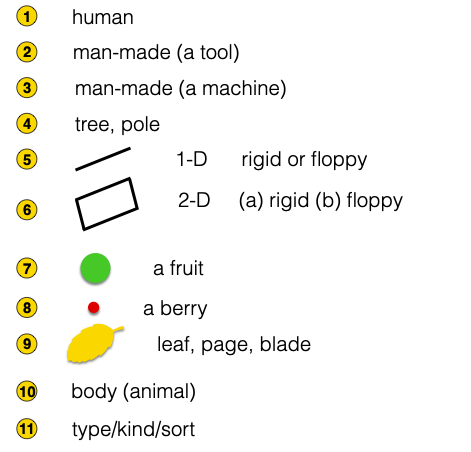
Maybe fusing with the number that modifies them.
..
... Happenings overlapping
..
I call ʔés and hogi "overlap words".
You sometimes come across them referred to as "aspectual operators" or "aspectual particles" in the Western Linguistic Tradition.
Most languages have equivalents to these two particles ...
..
| English | already | still |
| German | schon | noch |
| béu | ʔés | hogi |
| French | déjà | encore |
| Mandarin | yîjing | hái |
| Dutch | al | nog |
| Russian | uže | eščë |
| Serbo-Croatian | već | još |
| Finnish | jo | vielä |
| Swedish | redan | än(nu) |
| Indonesian | sudah | masih |
..
hogi indicates ...
1) An activity is ongoing.
2) The activity must stop some time in the future, possibly quite soon.
3) There is a certain expectation* that the activity should have stopped by now.
ʔés indicates ...
1) An activity is ongoing.
2) The activity was not ongoing some time in the past, possibly quite recently.
3) There is a certain expectation* that the activity should not have started yet.
..
* Inevitably a connotation of "contrary to expectation" will develope to a certain degree. This is because if the situation was according to expectation often nothing would need be utterred. Hence hogi and ʔés are often found in contrary to expectation situation which in turn colours their meaning.
..
..
A very interesting thing about the overlap couplet is how they are negated cross-linguisticly. Either the particle can be negated or the verb can be negated. The first case I represent with a bar over the operator+verb. The second case with a bar over the verb only.
Notice ... compared to the positive case, if the operator+verb is negated ... the line that represents onset/cessation of activity is moved to the other side of the dashed line representing "now".
Notice ... compared to the positive case, if the verb is negated ... then the yellow place becomes white and the white space becomes yellow.
..
..
As you see by above ... by changing whether the negator act on the operator+verb or whether only on the verb give diametrically opposite meanings.
Note that there are 4 possible negative cases to choose from and a language only needs 2. A language (to cover all negative cases) should be either "(a) (b) type" or "(c) (d) type" or " (a) (c) type" or "(b) (d) type"
Cross linguistically there are interesting variations. All Slavic languages prefer verb negation, hence they are (c) (d) types.
In German, only (a) and (c) are allowed in positive declarations.
Nahuatl has negation of the operator so is (a) (b) type.
English is a bit tricky ... it has suppletion and uses "not yet" for situation (c) and "no longer" for situation (d). Now in English "yet" means pretty much the same as "still". I believe "yet" was the original particle but "still" over time largely usurped it in the positive case. However the form "not yet" ... if taken at face value would seem to negate the operator. But it doesn't. Logically it would make more sense if we said "yet not" instead of "not yet" [i.e. we have situation (c) rather than (b)]. I am sure there is a perfectly good explanation for this reversal but unfortunately I do not know it ... anyway ... nothing to worry about too much. [ The form "not work yet" seems more logical in its word order ... how can "not" in "not yet work" have "work" under its scope but not "yet" ... but apparently that is the way it works ]
In béu, bù negates the whole clause and jù simply negates the following word. In béu to negate a clause containing hogi or ?és, jù is always inserted immediately before the verb. It can be seen that it patterns with the Slavic languages.
..
| hogi | kod-a-r-a | dían |
|---|---|---|
| still | work-1SG-IND-PRES | here |
| ʔés | kod-a-r-a | dían |
|---|---|---|
| already | work-1SG-IND-PRES | here |
| hogi | jù | kod-a-r-a | dían |
|---|---|---|---|
| still | not | work-1SG-IND-PRES | here |
| ʔés | jù | kod-a-r-a | dían |
|---|---|---|---|
| already | not | work-1SG-IND-PRES | here |
..
These operators are usually used to specify overlap with present time ... (I call the present time, NOW, in the diagrams). I would think this is true of every language (notice that the above examples the tense is always -a). However it is a trivial matter to reference the time of onset/cessation of activity to a different time ... you just change the tense.
..
... Non-zero reference time
..
If the reference time is not NOW, we have an overlap-word clause, non-zero reference time.
The example below has a refernce time in the past. This is shown by having verb in the past tense. (Note to specify tense, person must first be specified ... I went for 3SG)
..
..
To have the reference time in the future, simply put the future tense on the verb.
Now when you have a reference time other than NOW, this reference time must be already understood by all or it must be explicitly stated. For example ...
| ʔès | kod-o-r-i | dían | kyù | baba ò | dai-o-r-i |
|---|---|---|---|---|---|
| already | work-3SG-IND-PAST | here | when | his father | die-3SG-IND-PAST |
..
In the above examples, the reference times are not NOW but are specified by another action (or state).
..
... When the overlap is specified
..
Sometimes the time of overlap between the reference time and the onset/cessation of activity is specified. I call this an overlap clause with absolutely specified overlap time.
By the way ... overlap clause, specified overlap time and a plain overlap clause have significantly different meaning ... ʔès and ʔàn clause are focused on the present time ... if an "offset time" is added then we focus on a period of past time extending into the present or a period of time extending from the present into the future. For example ...
| ʔàn | kod-a-r-u | dían | áus | euca | yìa |
|---|---|---|---|---|---|
| yet | work-1SG-IND-FUT | here | period | seven | year |
| ʔès | kod-a-r-a | dían | áus | euca | yìa |
|---|---|---|---|---|---|
| already | work-1SG-IND-FUT | here | period | seven | year |
Note ... If I wanted to give logical symmetry to the two case I could have used the present tense (kodara) for both. However the human mind treats past time and future time very different ... the future action is uncertain.
I thought this difference in treatment should be reflected in the grammar ... as in fact it is in most natural languages ... so ʔàn kodaru dían euca yìa instead of ʔàn kodara dían euca yìa
..
Negating the above
..
Now we have already said that béu is basically an (a) (b) type language.
However if we have a specified offset time it becomes (c) (d) type.
The negator used in this case is jù rather than bú.
To explain the reason for this .... well take the case of the English sentence ... "I have worked here for seven years" [ ʔàn kodara dían euca yìa ]
Now if we negate the English we get "I have not worked here for seven years"
However this is ambiguous ... does it mean "I have been idol for seven years" or "I have worked for a period of time different from seven years"
béu avoids this ambiguity by using the negative operator jù which only negates the element immediately following. So ...
"I have been idol for seven years" => ʔàn jù kodara dían euca yìa
"I have worked for a period of time different from seven years" => ʔàn kodara dían jù euca yìa
..
..
Note : the bottom left one is ?àn jù kodara euca yìa rather than *?ès jù kodara euca yìa
THIS IS BECAUSE ?
The rule is that bù is not allowed in a clause that has ʔès/ʔàn and an "specified offset time".
Note ... in English, one of the functions of the perfect is to indicate that an action started sometime in the past and is still going on. For example ... "I have worked here for seven years". In béu this is indicated by ʔès ...
..
While we are discussing this area I really should mention the béu non-overlap clause with duration and present tense.
If a time period is mentioned with a verb in béu the time period denote how long the activity went on for ... the duration of the activity (the duration usually follows the verb and no preposition ... like "for" ... is needed). However if ʔès/ʔàn are in the clause, the time period mentioned refers not to duration but to overlap. In this section we only talk about clauses with duration.
For the i, e and u tenses these constructions are self explanatory. For example ...
| kod-a-r-i | dían | áus | euca | yìa |
|---|---|---|---|---|
| work-1SG-IND-PAST | here | period | seven | year |
However duration along with a present tense is worth mentioning.
| kod-a-r-a | dían | euca | yìa |
|---|---|---|---|
| work-1SG-IND-PRES | here | seven | year |
In the above example ... we are told that the total work period is seven years, but we get no information about how far we are through this seven year period. One doesn't hear this construction (present tense along with a time period) that often, but when you do hear it, its meaning is quite clear.
..
PS ... If you want to know more about aspect operators "The Meaning of Focus Particles" by Ekkehard König is the book for you.
..
... Restrictions
..
Let us discuss restrictions on these particles for a moment. Three rules to remember ...
1) lói and màs can co-exist with any particles from slot 2.
2) lói and màs can co-exist with bù from slot 3 but not with jù.
3) No particles from slot 2 can co-exist with bù.
4) Only ?àn and ?ès from slot 2 can co-exits with jù.
..
One usage of jù (slot 3) is mentioned above. Another usage is in certain SCV's. For example "listen not hear" ... "look not see" ... "try not succeed" where jù replaces the normal lé between the verbs.
[ ANY OTHER USAGE ? ]
..
..... Numbers
..
The standard set comprises of the numbers from 1 to 172710 (which is 1 to 100012 in base twelve). Every number in the standard set has a unique form.
Five random numbers are given below to demonstrate ...
| oila | = 6 |
| eucaifa | = 7212 |
| odauba | = 50312 |
| odaugaiba | = 54312 |
| oilaugai | = 64012 |
..
And below is how these numbers are written within a body of text.
..
Within a body of text ("textblock" from now on) a number written vertically and is headed up by a special three sided bracket. The only use of this bracket is to indicate a number within a textblock.
Below this bracket, the number is written with a letter representing each digit of the number
Under the bracket the number is written using a letter symbol.
| letter | digit | ..... | letter | digit | ..... | letter | digit | |||
| J | => | 1 | D | => | 5 | K | => | 9 | ||
| F | => | 2 | L | => | 6 | P | => | 10 | ||
| B | => | 3 | C | => | 7 | T | => | 11 | ||
| G | => | 4 | S | => | 8 |
You can see that base 12 is being used. (just for explanatory purposes I will use "T" for 10 and "E" for 11)
More or less the same symbols is used for the number digit as for the letter. They take their initial, medial or final form, depending on whether the are the first, second or third number of the three digit group. táu ʔusʔa is used for inserting zeroes. táu ʔusʔa is never pronounced, it is only a place holder as number magnitude depends on position.
Although there is a unique word for 1727 numbers, it is not necessary to memorize 1727 unique forms. The 1727 numbers are built up from smaller elements. These elements are shown below ...
..
| 10012 = | ajau | 1012 = | ajai | one = | aja |
| 20012 = | ifau | 2012 = | ifai | two = | ifa |
| 30012 = | ubau | 3012 = | ubai | three = | uba |
| 40012 = | egau | 4012 = | egai | four = | ega |
| 50012 = | odau | 5012 = | odai | five = | oda |
| 60012 = | oilau | 6012 = | oilai | six = | oila |
| 70012 = | eucau | 7012 = | eucai | seven = | euca |
| 80012 = | aizau | 8012 = | aizai | eight = | aiza |
| 90012 = | aukau | 9012 = | aukai | nine = | auka |
| T0012 = | yapau | T012 = | yapai | T = | yapa |
| E0012 = | watau | E012 = | watai | E = | wata |
..
To construct a number from the above ...
1) Select which elements you need. For example, for 54312, you will need the elements odau + egai + uba
2) If the element is non-initial, delete the initial vowel of the element => odau + gai + ba ... (note that ya and wa were originally ia and ua ... they should be deleted)
3) Join the elements up => odaugaiba
..
There is a soecial form for 1, 2 and 3 ... aja, ifa and uba, while used for building up larger numbers, are never used by themselves when qualifying animate things. Instead we use ...
..
| ʔà | one |
| hói | two |
| léu | three |
..
ʔà along with its plural form ʔài are also used to code indefiniteness ???
..
Numbers are never written out in full. Always the method given above is used. It is as if in a body of English text you never came across the "seven" but only "7".
..
Note ... If you had a leading zero you would use the word jù. 007 would be jù jù euca (three words). To deal with a telephone number, you would lump the numbers in threes (any leading zero or zeroes by themselves though) and outspeak the numbers. If you were left with a single digit (say 4) it would be pronounced egau. If you were to pronounce it ega, it would of course mean 004. Also you would probably add the particle dù at the end.
..
... Ordinal numbers
..
With fractions, cardinal numbers and numbers denoting group size, there is the choice of writing 7th or seventh. That is you can either use the symbols given below or you can write out in full ... in this example dega, lega and egan.
..
..
If an ordinal number within a NP specified it is just the bare number inserted in the adjective slot. For example ...
bàu léu = the third man
If the ordinal number appears outside a NP its form is as follows ...
..
| ?à | one | --- | da?a | first | --- | laja | whole | --- | ajan | a unit | --- | ajas | once |
| hói | two | dahoi | second | lifa | a half | ifan | a double | ifas | twice | ||||
| léu | three | daleu | third | luba | a third | uban | a treble | ubas | thrice | ||||
| ega | four | dega | fourth | lega | a quarter | egan | a quartet | egas | four times | ||||
| oda | five | doda | fifth | loda | a fifth | odan | a fivesome | odas | five times | ||||
| oila | six | --- | doila | sixth | --- | loila | a sixth | --- | oilan | a sextet | --- | oilas | six times |
..
Probably a contraction of dà oda ... "place five" ... for example ...
dahoi r jene or jene r dahoi = "second is Jane" or "in second place is Jane" or "Jane is second" or "Jane is in second place"
..
An -n can also be affixed to make it more definite (that is saidau => saidaun) ...
dahoin rò jene or jene r dahoin = "the second one is Jane" or "Jane is the second one"
..
... Numbers ... (the extended set)
..
So far we have covered the standard set (1 -> 1727). To expand this into "the extended set" we use "magnitude" words. There are seven of these.
..
..
The first column gives the magnitude symbol, the second ... how the symbol is pronounced, the third ... the meaning*, and the last ... the magnifier that the symbol represents.
Two of the magnitude words have been eroded from the original aninal name, 100012 is now represented by wú rather than the original wúa and 1/100012 is now represented by yàn rather than the original yanfa.
.* Yes all the magnitude words double up as animal names. But actually this never causes any problem. If you hear huŋgu huŋgu you know it means "5,159,780,352 Swans" ... there is no ambiguity.
To demonstrate the use of the magnitude words, let's take a long number ... 1,206,8E3,051.58T,630,559
Which is written as ...
and pronounced as ... aja huŋgu ifaula nàin aizautaiba wú odaija ʔomba odauzaipa yàn oilaubai mulu odaudaika ʔiwetu dù
You can see that the digits are still grouped into bunches of three. Within the triplets, leading zeros can be dropped ... giving doublets or even singletons.
All the magnitude words are spoken out. Notice the final dù. This means "exactly". You usually add this when pronouncing numbers from the extended set.
Now when numbers of the extended set are used to qualify a noun they are placed after that noun with the partitive particle làu between the number and the noun. For example ...
3,05112 elephants = sadu làu uba wú odaija ............ Note ... the singular form of senko always used when quantity is given by this method.
Also if fractions or indeed any non-integer number is used, it must be applied using làu. However non-integer things are likely to be olus and we have already degreed that olus quantifiers are partitive measure phrases.
When you write an extended set number, you must finish the number off with a bracket. (in contrast the final bracket is never used if the number is from the standard set)
Anyway ... the above is only an example. You are unlikely to find something with so big a dynamic range within a textblock.
Below are examples of numbers which you would more typically find in a text block ...
Pronounced uba wú odaija dù and odaija ʔomba odauzai respectively.
(a) uba wú odaija dù is an whole number.
odaija ʔomba odauzai is not a whole number. Notice that the 4 versions of odaija ʔomba odauzai have been given different kinds of final brackets.
(b) This one shows that 51.5812 is an approximation to the actual value. cedua odaija ʔomba odauzai
(c) This one shows that 51.5812 has been rounded down. That is .. if A = "actual value", then 51.59 =< A =< 51.58. This is pronounced odaija ʔomba odauzai laila gòi
(d) This one shows that 51.5812 has been rounded up. That is .... if A = "actual value", then 51.58 =< A =< 51.57. This is pronounced odaija ʔomba odauzai laila máu
(e) This one shows that 51.5812 has been rounded up or down to the nearest digit. That is .... if A = "actual value", then 51.585 =< A =< 51.575. This is pronounced odaija ʔomba odauzai laila
..
dù and daula ( plus ? plus ? plus ?) as well as giving information about the accuracy of the number, also lets the listener know that the speaker has finished.
..
... Numbers ... (free form + plus mathematical notation)
..
The numbers considered above were all in what is called "block form". That is ... the form they appear as within a body of text. There is also a way to write numbers when they are not inside a text block. That would happen on a page given over to mathematical formula. In this environment the numbers are written horizontally ... from left to right. There are some slight differences between the free form version of the numbers and the block form versions. The free form version of the numbers are ...
As with the block form, they always occur in triplets. However their form doesn't vary depending on which one of the triplets the character is ... the digits are always exactly the same. There is a special egg-shape symbol for zero (actually called táu kyái, where kyái means "egg"). In free form it is not permitted to drop leading zero's ... well not triplet leading zero's, word leading zero's can of course be dropped.
Below is how the five numbers given previously appear in free form ...
And that long number mentioned in the previous section (a number from the extended set) ...
It is, of course, pronounced exactly as the block form number. That is ... aja huŋgu ifaula nàin aizautaiba wú odaija ʔomba odauzaipa yàn oilaubai mulu odaudaika ʔiwetu dù
..
Below are some more symbols used in mathematics. These would appear in a free form page (or part of a page).
..
..
The top 3 symbols in the leftmost column designate "operations". These modify a number and are placed immediately left of the number they modify. If a number has more than one operator they come in the order "minus sign", then "i", then the inverse ("1/x") symbol.
..
And below is a few examples of equations written in this notation.
..
..
..... The perfect versus "already"
WELL NOW I HAVE gwò AND ?ès occurring in the same slot. Now they can not co-exist. So I don't have to worry about the below ...
..
In English the perfect and "already" in many situation impart the same meaning to a clause. For example ...
1) She has gone to town ................ could have the experiential meaning.
2) She went to town already ......... no current relevance implied
3) She has already gone to town ... the addition of "already" brings us to the-here-and-now.
(Note to self ... think about this a bit more ... maybe the choice of verb "go" was infelicious ... whoever witnesses that as a complete event ??)
In béu ʔès and the perfect marker gwò can not be used together. They are two completely different things. For example ...
..
..
1) When you use ʔès (or ʔàn) you are concerned about the onset/cessation of an event ... probably in the recent past or near future.
2) When you use the perfect aspect you are concerned about the state of the subject (A or S) which has resulted from some event that might be quite far in the past ... impinging on this is a stong "experential" connotation. For example ... if John has read a book on geometry, you can assume he has some knowledge of this subject. If he has been to London, you can assume he has many sounds and sights of London stored away in his memory.
The meaning imparted by -gwò is ...
a) The action is completed (some languages don't have a "perfect" but show "incompleted action" by having the "O" arguments in the partitive case). This is the base meaning of the perfect. In fact many perfect markers are derived from grammaticizing some word that means "finish".
b) There are "present consequences" to the action. This comes about because in most situations which are given a perfect marker THERE ARE "present consequences". Hence "present consequences" come to see associated with the perfect marker (a very simple process but behind all instances of grammaticization).
c) The subject has done the "action" once hence he has experienced the action and everything it involves.
..
-gwò is used if the action is short compared to the total time frame being considered.
?ès is used if the action is long compared to the total time frame being considered. This is the same thing as saying that the action extends into NOW or into some other reference time.
..
..... IA and UA
..
| ìa | to finish, to complete |
| úa | to run out, to be exhausted, to be used up |
..
The first one being a transitive verb and the second one an intransitive verb.
Two fundamental concepts ... needed ever since humans started doing complex tasks and since humans started storing stuff for later use.
These two, as well as appearing in their r-form also appear as particles which can be analized as verbs of a verb chains. Their forms are slightly irregular, but yə could be imagined as the i-form that ìa would take and wə could be imagined as thei-form that úa would take.
I finished building the house => tìa yə bundari
She finished off the cake => kekeu wə flori
Notice that in the first example the object is fully formed after the action hence yə. In the second example the object has fully disappeared after the action hence wə.
In some situations, either yə or wə would be appropriate.
For example "I finished writing the book" ... here the "pages to be read" have disappeared, but the "read pages" are at a maximum.
toili yə kludar = I have finished writing the book : toili yə kludar = I had finished writing the book
[Note to self, should we have a sex distinction here, with males using yə and females using wə. ]
Actually ... what would actually constitite the O argument of ìa is worth discussing.
There is always some underlying verb being referenced by ìa even though it is not expressed.
tìa ia.iri @ = have you finished the house ? ... here the underlying verb is bunda "to build"
And as another example ...
kekeu ia.iri ?ai? = have you finished the cake ? ... actually here we have two possible underlying verbs : gàu "to make" or flò "to eat" ... the one which is appropriate would be known from the background knowledge of the situation.
You could analyse ìa as
1) Always having a complement clause as O argument (with the maŋɡa usually dropped because it is so predictable.
2) Sometimes having a noun as O argument, and sometimes having a complement clause as O argument.
If analysis (1) is accepted, then ìa is the only verb that doesn't ... sometimes ... take a noun as its O argument.
Using R.M.W. Dixon's terminology ... ìa would be the only SECONDARY VERB* in the language of béu.
Actually in this case I think there is no benefit in analyzing ìa as (1) or (2). I know this leaves things a bit messy ... i.e. "pehaps there is only one SECONDARY VERB in béu. But one of the characteristics of natlangs is that they ARE messy. Think of ìa as my tribute to the messiness of natural languages :-)
[ As there is no benefit in analyzing an electron as either a particle alone or a wave alone. I find it a bit baffling to hear linguists arguing at length over ... say ... what is the "head" of a prepositional phrase is. "head" is just a construct to make it easy for linguists to talk about languages ... unfortunately it is part of the human psyche to believe that if you have a name for something, then that something must exist ... but I am digressing a bit here. ]
* This term is explained in "Complementation, a cross-linguistic typology" by Dixon and Aikhenvald.
..
... Two old participle
..
í and fì appear often in conjunction with manga
These constructions act as adjectives. Along with là, they differs from all other pilamo in that, with a manga, they never stands alone. For example ...
sòr kludaun = He/she is about to write
sòr kludaufi = He/she has just written
sòr kludaun toili = He/she is about to write a book .......................... *sòr í kludau toili
sòr kludaufi toili = He/she has just written a book .......................... *sòr fì kludau toili
bàu timpafi glá = The/a man who has just hit the/a woman .......... *bàu fì timpa glá
bàu timpan glá = The/a man just about to hit the/a woman .......... *bàu í timpa glá
toili jwoifi kludau = The/a book that has just been written ............ *toili fì jwòi kludau
*toili jwòin kludau = The/a book that is just about to be written ... *toili í jwòi kludau
These can be called the present+ participle and the present- participle.
..
... Old perfect
..
This slot can have the "perfect aspect marker" jə or it can be empty.
..
The perfect tense, logically doesn't differ that much difference from the past tense,. but it is emphasizing a state rather than an action. It represents the state at the time of speaking as the outcome of past events. We have this aspect in English and it is realized as "have -en".
For example if you wanted to talk to John and you went to his office, his secretary might say "he has gone to lunch, this emphasizes the absence of John as opposed to "he went for lunch". The latter is just an action that happened in the past, the former is a present state brought about by a past action.
For another example ... "she read the book on geometry"
This doesn't specify whether she read it all the way thru or whether she just read a bit of it. Whereas ...
"she has read the book on geometry", implies she read the book all the way thru, but more importantly the connotation is that at the present time she has knowledge of geometry.
The total verb suffix system is given below.
..
..
The aortist tense can not occur with the perfect. It may appear that it does though. This is because the a of the present tense is dropped if jə is appended directly on to it. So ...
doikora = He is walking
doikoras = The say he is walking
doikoran = I guess he is walking
doikorjə = He has walked ... or to be more specific ... "from the beginning of time until now he has walked at least once"
doikorazjə = They say he has walked
doikoranjə = I guess he has walked
The perfect marker -jə was probably derived from jà "to finish/to complete" in its verb chain form. The perfect aspect occurs in roughly half of the languages of the world ... http://wals.info/chapter/68
..
... Old, old stuff
1 wepua
2 mazeba .......................... and 2 demonstratives
3 plova ......... participles ........ ʔinʔanandau or whatever words
4 teŋko ........ evidentials ........ relativizers or ʔasemo-marker
5 seŋgeba ..... modals ..... and 5 specifyana
6 ʔanandau ... question words
7 cenʔo ......... subject marked on the verb
9 ??? .............. personal pronouns
12 pilana (noun cases),
15 "specified"
16 gwoma (tense/aspect verbal affixes).
best to have 10 ??? conjunctions ???
... This material goes back a long way ... to the time I was thinking of making the passive with an aw infix
..
The three types of Verb
..
Some concepts are naturally intransitive. Like "to shave". Well at least in béu it is very unusual to shave another.
Some concepts are naturally transitive. Like "to hit". It is worth remarking on when somebody hits themselves.
And there are also some concepts that appear in both manifestations. For example ... "turn", "spread", "rise/raise"
These three types of concept are represented in beu by three different types of verb.
V1) té = to come ... this is a intransitive verb
(Always accompanied by a naked noun)
V2) timpa = to hit ... this is a transitive verb
(Always accompanied by an s-marked noun and a* naked noun)
*Although sometimes the naked noun can be dropped for lack of interest. For example ...
jenes solbori = Jane drank (something)
V3) kwèu = to turn
Now this sometimes behaves like V1 and sometimes like V2.
..
A .. V1 Derivations
..
There are 5 deriuvation processes shown below ...
First from doika => doikaya This involves infixing ay before the final vowel.
Secondly from doika => doikana and doikaya => doikayana.
This involves deleting the final vowel and adding ana.
Thirdly from doika => doikala and doikaya => doikayala.
This involves deleting the second part of the final vowel if it is a diphthong, and then adding la.
Fourthly from doikaya => doikaiwai.
This involves deleting the final vowel and y and adding iwai.
Fifthly from doikaya => doikaiwau.
This involves deleting the final vowel and y and adding iwau.
..
| doskania | <============ | doskan | ============> | doskanua |
| "which has been melted" (A) | "to melt" (transitive) | "which must be melted" (A) | ||
| ^ | ||||
| | | ||||
| | | ||||
| doska | <============ | doska | ============> | doskal |
| "which melts" | "to melt" (intransitive) | "melting" (A) |
..
B .. V2 Derivations
..
There are 5 deriuvation processes shown below ...
First from kludau => kludawau This involves infixing aw before the final vowel.
Secondly from kludau => kludana and kludawau => kludawana.
This involves deleting the final vowel and adding ana.
Thirdly from kludau => kludala and kludawau => kludawala.
This involves deleting the second part of the final vowel if it is a diphthong, and then adding la.
Fourthly from kludau => kludwai.
This involves deleting the final vowel and adding wai.
Fifthly from kludau => kludwau.
This involves deleting the final vowel and adding wau.
..
| kludawana | <============ | kludawau | ============> | kludawala |
| "computer memory" (N) | "to be written" (V2) | "being written" (A) | ||
| ^ | ||||
| | | ||||
| | | ||||
| kludana | <============ | kludau | ============> | kludala |
| "writer" (N) | "to write" (V1) | "writing" (A) | ||
| kludwai | kludwau | |||
| "written" (A/N) | "which must be written" (A/N) |
..
kludwai is the passive past participle, and kludwau is the passive future participle.
..
Note that we have 8 word forms in total.
..
C .. V3 Derivations
..
| haikana | <============ | haika | ============> | haikala |
| "breaker" (N) | "to break" (V3a) | "breaking" (A) | ||
| haikwai | haikwau | |||
| "broken" (A/N) | "that which must be broken" (A/N) |
..
Note ... haikwai could very well have broken by itself. There is no connotation that an outside agent was responsible. The same with haikwau.
..
| heukana | <============ | heuka | ============> | heukala |
| "breaker" (N) | "to break" (V3b) | "breaking" (A) |
..
There are 4 derivational processes involved with V3a and 2 derivational processes involved with V3b. They have been already been explained in the sections on V1 and V2.
Note that we have 8 word forms in total.
kó = to see
kowa = to be seen
The subject of the active clause, can be included in the passive clause as an afterthought if required. hí is a normal noun meaning "source". However it also acts as a particle (prefix) which introduces the agent in a passive clause.
poʔau = to cook
..
When the final consonant is w y h or ʔ the passive is formed by suffixing -wa
In monosyllabic words, it is formed by suffixing -wa.
Note ... when wa is added to a word ending in au or eu, the final u is deleted.
Also note ... these operations can make consonant clusters which are not allowed in the base words. For example, in a root word -mpw- would not be allowed ( Chapter 1, Consonant clusters, Word medial)
..
... Valency ... 1 => 2
..
Now all verbs that can take an ergative argument can undergo the 2=>1 transformation.
There also exists in béu a 1=>2 transformation. However this transformation can only be applied to a handful of verbs. Namely ...
| ʔoime | to be happy, happyness | ʔoimora | he is happy | ʔoimye | to make happy | ʔoimyana | pleasant |
| heuno | to be sad/sadness | heunora | she's sad | heunyo | to make sad | heunyana | depressing |
| taudu | to be annoyed | taudora | he is annoyed | tauju | to annoy | taujana | annoying |
| swú | to be scared, fear | swora | she is afraid | swuya | to scare | swuyana | frightening, scary |
| canti | to be angry, anger | cantora | he is angry | canci | to make angry | cancana | really annoying |
| yodi | to be horny, lust | yodora | she is horny | yoji | to make horny | yojana | sexy, hot |
| gái | to ache, pain | gayora | he hurts | gaya | to hurt (something) | gayana | painful * |
| gwibe | to be ashamed/shame/shyness | gwibora | she is ashamed/shy | gwibye | to embarrass | gwibyana | embarrassing |
| doimoi | to be anxious, anxiety | doimora | he is anxious | doimyoi | to cause anxiety, to make anxious | doimyana | worrying |
| ʔica | to be jealous, jealousy | ʔicora | she is jealous | ʔicaya | to make jealous | ʔicayana | causing jealousy |
ʔoimor would mean "he is happy by nature". All the above words take this sense when the "a" of the present tense is dropped.
The above words are all about internal feelings.
The third column gives a transitive infinitive (derived from the column two entry by infixing a -y- before the final vowel).
The fourth column gives an adjective of the transitive verb (derived from column three entry by affixing a -ana ... the active participle).
When the final consonant is ʔ j c w or h the causative is formed by suffixing -ya.
Also when the verb is a monosyllable, the causative is formed by suffixing -ya.
Note ... when ya is added to a word ending in ai or oi, the final i is deleted.
Note ... when y is infixed behind t and d : ty => c and dy => j
..
Normally in béu, to make a nominally intransitive verb transitive, it doesn't need the infixing of -y. All it needs is the appearance of an ergative argument. For example ...
doika = to walk
doikor = he walks
doikanor the pulp mill = he runs the pulp mill
doikandoi = management
..
*You would describe a gallstone as gayana. However you would describe your leg as gaila (well provided you didn't have a chronic condition with your leg)
..
................... To be looked into
The words kyò "show" and fyá "tell" follow the same pattern as 1) and 2) ... at least when the object is a noun and not a complement clause.
helga = life, helgai = alive, helgais = finite verb (i.e. the one that is alive), helkas = a clause (helkas <= helgaiskas ), swefan = a sentence
In béu we have live clauses and dead clause.
The head of a live clause is a verb in its declarative form.
The head of a dead clause is a verb in its declarative form.
A live clause has its main elements in any order, the S term is marked as the ergative. The A and O terms are unmarked.
A dead clause has word order VS or VAO, the O term being marked as the dative. The A and S terms are unmarked.
If the subjects (that is S or A) of two clauses are different then they can be conjoined timewise by using one of the above stand-alone particles. For example ...
1) jenes bwori jono ʔéu jonos fori tìa tí = Jane saw John as he was leaving his house.
Also ... as in English we can have the two clauses in the other order ...
2) ʔéu jonos fori tìa tí_jenes bwori ò = As John was leaving his house, Jane saw him
Notice that in this sentence, the second jono has been replaced by the pronoun ò ... in actual fact ... in 1) the chances are that jonos would be replaced by ós ... but this makes the sentence ambiguous.
John whistled as he left his house = jono wizori ʔéu ò fori tìa tí = *jono wizori ʔéu féu í tìa tí
---
Now if the subjects of two clauses are the same, one of the clauses can becomes a dead clause. Only a very short and simple clause can become a dead clause ... both ...
A) Any time,place or manner adjuncts will stop a clause collapsing to a dead clause.
B) An O argument that is longer than a single word.
When the above requirements are met ....
A) S or A is dropped completely.
B) The linker word is appended to the infinitive.
C) if there is an O it immediately follows the infinitive and has the dative marker -n affixed.
..
1) S while S ................... jono wizori ʔéu ò huzori ... (pronoun used in second clause) => jono wizori huzuaspi = John whistled while smoking
2) A/O while A/O ..... jonos timpori jene ʔéu ós huzori ʃiga ... (pronoun used in second clause) => jonos timpori jene pi huzuas ʃigan ... (must drop A, the linker must be appended to the infinitive. O must be a single word)
3) A O while S .......... jonos timpori jene ʔéu ò huzori ... (pronoun used in second clause)
=> jonos timpori jene huzuaʔeu ... (must drop S, the linker must be appended to the infinitive)
4) S while A O ........... jono huzori ʔéu ós timpori jene .... (pronoun used in second clause)
=> jono huzori timpaʔeu jenen .... (must drop A, the linker must be appended to the infinitive. O must be a single word)
John left his house whistling = Jonos fori tìa tí ʔéu wiʒia
wiʒia = to whistle
koʔia = to cough
huzua = to smoke
TO THINK ABOUT
Now we have said before that béu has free word order, however this really only applies to the verb in r-form (R) and the S argument in an intransitive clause, and the R, A and O in a transitive clause. When you have a verb in gomia-form (G), in the subjunctive form (Sub) or in the imperative form (Imp), you must have these elements in the following order ;-
S G : S Sub ... the last of these (S -S ) is quite unusual. Maybe can have S I ... but then S must be in vocative case
A G O : A Sub O : Imp O ... expand this and make it look good. Maybe can have A I O ... but then A must be in vocative case
In the béu linguistic tradition, a clause that has one R verb in it, or one N verb, or one I verb is called aʒiŋko baga or a simple clause. Any clause that has an R verb plus an G or N, verb is called a aʒiŋko kaza or a complex clause.
To think about ..........
Further uses of the s-form of the verb. That is the subjunctive.
Also used in dependent clauses with the meaning ...
that xxx should yyy.
Used after "want/hope/believe ?" if the subject is different. If subject is the same then the verb is in the gomia form.
hear, see, think, like, remember, know, believe | use tà + full verb with FACT complements.
hear, see, like, remember | use gomia with ACTION complements (English would use "-ing")
Sometimes when English would use the "to" construction, béu would use the -u participle | remember
Some rubbish ........
gwói = to jump (involuntarily), to give a start
gwóin = to make somebody jump, to give somebody a start
doika = walk
doikan = to manage, to run ......... doikandoii = "the management" or "the managers"
poma = leg
poman = to kick, pomanari = I kicked
pomaswan = liable to kick, fond of kicking
pomonda = good to kick
klonda = worth seeing
To fix up this bit.....Of course we can make two clauses, and have the second clause one element inside the first clause. To do that you must use the particle tà. Equivalent to one of the uses of "that" in English. tà basically tells you that the following clause should be treated like a single element, like a single noun.
I should mention sá tà ...
solbe = to drink
heŋgo = to live (or it could mean "a life")
soŋkau = to die (or it could mean "death")
glabu = person
moze = water
moʒi = steam
heŋgola = alive, living
soŋki = dead
..
... Two quotative verbs
..
béu has two quotative verbs ... swé and aika. What I mean by the term "quotative verb"is a verb which must* be accompanied by a string of direct speach ["sods" from now on]
swé = "say" and aika = ask .... ( that is to ask for information, to request something (to ask for) has a completely different root ... namely tama )
I guess it is intransitive because the speaker never takes the ergative ending "s". The spoken to (if mentioned) takes the dative ending "n".
[Some people would like to argue as to whether "sods" = an object or whether "sods" = a complement clause. I think this is not worth arguing about. It is similar to arguing about how many angels can stand on the end of a needle. ]
There is an ordering restrictions for a clause formed around a quotative verb ... the "sods" must appear adjacent to swé or aika. It doesn't matter which comes first but they must be adjacent ... normally both elements are pronounced in the same intonation contour. A second restriction is that there must be a pause at the other end of the "sods" ... the opposite end from the quotative verb. For example ...
John said "Ai ... go away" => jono swori aiʔdo ... ojo where aiʔdo is an interjection expressing frustration and ojo is quite a rough way to say "go away".
This can also be expressed as aiʔdo ... ojo swori jono or jono ... aiʔdo ... ojo swori or even swori aiʔdo ... ojo ... jono. The first two patterns are the most common followed by the third pattern and the fourth a distant last. Notice that the "sods" that I chose for demonstration purposes entails an internal pause.
If we introduced a dative element ...
John said to Jane "Ai ... go away" => jono jenen swori aiʔdo ... ojo
The above would be the most common ordering of constituents ... but again quite a bit of freedom with respect to word ordering.
The "sods" can be quite lengthy ... 2 or 3 or 4 clauses and follows as near as possible the speach pattern of the original speaker.
The béu orthography is a bit quirky when it comes to quotative verbs. In CH 1.8 we briefly mentioned the deupa. These are actually used to bracket any "sods". Also it is common to drop the actual quotative verb. (well after the time setting of the speach act(s) are revealed anyway). For example ...
The first one is graphically jono [ aiʔdo ... ojo ] ... (for an explanation of the graffic form of the interjection aiʔdo, look back to CH 1.2)
The second one is graphically jono [ bàu nái ]
These would be read as jono swori aiʔdo ... ojo and jono aikori bàu nái (John asked "which man")
But how do we know that swé should be associated with one and aika to the other ? Simple ... if you have a question word within the deupa then you know you should pronounce aika ... if not you pronounce swé. We have encountered these question words already in CH 2.10. There are ten of them but the first two have two forms. Here they are again ...
..
| nén nós | what |
| mín mís | who |
| láu | "how much/many" |
| kái | "what kind of" |
| dá | where |
| kyú | when |
| sái | why |
| nái | which |
| ʔai? | "solicits a yes/no response" |
| ʔala | which of two |
..
The only time that you hear these ten words and you are NOT being asked a question is when these words are in the same intonation contour as the verb "aika" in one of its forms.
The only time that you see these ten words and you are NOT being asked a question is when these words are sandwiched between two deumai.
This is quite a bit different from English where question words have been appropriated to function as relativizers, complementizers and what have you (heads of free relative clauses).
In the above ... when pronouncing words ... swé or aika is inserted where the first bracket appears. It could equally well be that swé or aika is inserted where the second bracket appears. It is deemed to not really matter that much. However in carefull writting the proper position of the quotative verb can be indicated. For example ...
In the above a pause (gap) is visible just above the top deupa. From that it is logical to deduce that swé or aika should be inserted after the "sods". (from the word order and intonation rules given earlier). But most of the time ... when reading out loud ... people do not take much heed to whether the quotative verb is placed over the deupa damau or the deupa dagoi.
In a textblock, which you have a lot of dialogue it is common to colour code the "sods" with respect to the speaker. For example ...
When this happens the deupa has no gold filling. It could be possible to drop the speakers name also once the colour coding scheme is established. This really depends upon how much dialogue is involved. Maybe each speaker would be mentioned again at the start of every textblock ... just to keep the protagonist <=> colour mapping alive in the readers mind.
..
* In the very first sentence of this section I said that "quotative verb"is a verb which must be accompanied by a "sods" ... not quite true. The determiners dí and dè can take the place of a "sods". In these constructions dí refers to a "sods" that will be revealed imminently ... dè refers to a "sods" that was spoken in the past.
If Jane pronounces an opinion about something ... if John had pronounced roughly similar in the past ... it would be fitting to say jono swori dè.
If you are about to replay some utterance by John on a voice file, it would be appropriate to say jono swori dí just before playing the voice file.
..
IMPORTANT ... The only time you hear direct speech is when swé or aika is present in one of its forms.
..
... jía expressing the conditional
..
jía has three functions.
..
Also it has two shorthand forms ... the only word in the language to be so honoured. The leftmost word is never used. The => character used for the second function. The remaining character used for functions 1 and 3.
..
1) In most languages you can drop certain components if they are obvious from context. And when you do the remaining utterance stays unchanged. However béu does not work like that*. We saw in the previous section that the particles used to show cause/reason are different, depending upon whether they are followed by a simple noun or by a clause. The same happens when we are making a statement by way of comparison. For example ...
..
Thomas thinks as fast as John => tomo wòr saco làu jono
Now obviously "John thinks" is underlying here. However if you want to make "John thinks" overt you must change làu to jía ...
Thomas thinks as fast as John thinks => tomo wòr saco jía jono wòr
Notice that English patterns the same way for both the above examples.
..
2) In English we have the verb "to equal" ... it bit of a strange verb. Almost exclusively found in a mathematical setting. (The adjective "equal" has the same form as the verb "to equal" .. but anyway ... )
The béu particle jía is used in most situations where we find the English verb "to equal". In a setting such as 2+3=5 ... well there are no need for tense or aspect ... we are talking about a timeless truth. Also no need for person affixes ... the elements (arguments) involved are always stated the the left and the right of jía. Also no need for evidential markers ... the world of béu considers evidentials as appropriate for the human world ... but the world of mathematics is so far beyond the human world ... to have evidentials on a mathematical expression would be to drag the matheverse down into the dirt. Hence jía is an invarient particle. By the way jiagan = "equation".
..
3) The third function of jía is for considering contingencies. In English "if" is essential for considering contingencies. However "if" does not equate to jía. Let me explain ...
In English ... "if you go, they will kill you" ... two clauses ... the first introduced by "if" .... "if (A), (B)".
Sometimes "then" can introduce the second clause [ "if (A), then (B)"] but this is not considered essential in English. However some natlangs require a particle in front of the second clause. In Chinese the particle 就 jiù is needed.
béu requires gò in front of the first clause and jía in front of the second clause. For example ...
..
gò jiru jía gì dainuru => "if you go, they will kill you"
..
| gò | j-i-r-u | jía | gì | dain-u-r-u |
|---|---|---|---|---|
| that | go-2SG-IND-FUT | "equative particle" | you | kill-3PL-IND-FUT |
..
As well as Mandarin, French has a mechanism which is not a million miles away from the béu arrangement.
In classical and educated French, the complementizer "que" could function as a marker of protasis if the verb of the clause is in the subjunctive mood. The apodosis would be in the future tense, preceded by "et" (and) :
"Que je périsse, et elle périra" (périsse = subjunctive) = "if I perish, she will too"
"Si je péris, elle périra" (péris = indicative) = "if I perish, she will too"
..
* Now why have I set things up like this ... well in béu it is quite easy to define a clause. A clause is a chunk that contains one active verb (active verb = a verb having an "r" ). I guess I have set things up like this, so as to firmly draw a line between one clause constructions and two clause construction.
[ Note to self : why DO you want it like this ?]
..
... Here lies LIGA and TEKA
..
liga makes verbs which in themselves are quite compact more spread out. Possibly related to the verb ligai which means "to stay" or "to lie".
..
| koʕia | to cough | liga koʕia | "to be coughing", "to have a coughing fit" |
| timpa | to hit | liga timpa | "to be hitting" or "to assault" |
..
liga is never used with verbs that typically have an inherent long time duration. For example ...
*liga glarua beuba kewe would be translated as "I intend to be knowing the language of béu well" ... (not good in English either ... maybe OK in Indian English ?).
Simply glarua beuba kewe = "I intend to know the language of béu well" ... is more felicitous in both languages.
..
If translating from a language with a "perfective"/"imperfective" dichotomy, perhaps using liga for translation of the "imperfective" would work. However it should be dome sparingly. If every instance of "imperfective" was rendered with liga you would end up with a very very bad translation (the style would be judged attrocious by any béu speaker). Now in the very best register of béu this particle is used for a certain poetic effect, it is used sparingly and is not necessary for understanding what is being said. However people that are L1 speakers of a language having a perfective/imperfective tend to over-use liga. This is not really a problem, it just shows that they are not L1 béu speakers. Conversely people that are L1 speakers of language that lacks this distinction tend to not use liga enough. Again ... no real problem.
In certain situations liga can be translated as "keep". For example ...
liga doiku = keep walking
..
teka is the opposite of liga. It means "momentarily". Possibly related to the verb telka which means "to slip a little bit".
While in theory it can be used with almost any verb, it tends to be used disproportionately with a dozen or so verbs. For example ...
..
| bwí | to see | liga bwí | to watch over | teka bwí | to catch a glimpse |
| wòi | to think | liga wòi | to ponder | teka wòi | to think for a moment |
| ʕái | to want | liga ʕái | to yearn for | teka ʕái | to have an momentary urge |
..
So there is assymetry between the usages of liga and teka ... liga used with many verbs albiet verbs of short duration ... teka, while in theory can be used with many verbs, in practice the verbs usually used with it are quite restricted.
..
... Kyù and jé discarded
..
In the previous sections we have seen how to give time information. However there is another way to give the time ... with respect to an evert or action.
We will cover seven particles in this section which allow us to give time information with respect to an event ... jé kyù koca beda kogan began and jindu.
..
jé = kyù* = "while" or "when"
koca = before
beda = after
kogan = until
began = since
jindu = as soon as
In a similar manner to English, they can either introduce a clause, a noun (that designates a time) or an infinitive phrase (by the way ... I strongly object to the term "infinitive clause")
“After I ate breakfast”
“After the gold rush”
“After the eating of my breakfast”
The above are all time adverb phrases. A time adverb phrase is a dependent clause** (called an under clause in béu) ... shown in red below. The main clause is shown in yellow.
..
Tha arrow is the arrow of time*** ... with the past to the left (komo), and the future to the right (bene).
I have given events wavey borders to represent "not so well defined". So, for example, on the top diagram ... the main clause action could start before the under clause action ... it could also outlast the under clause action ... the important thing is that for a substantial amount of time, the two actions were going on at the same time.
In the bottom four examples I have made the under clause actions very short. This is for illustration purposes only. The under clause actions can actually have any length ... depend on the verb/situation.
Now these five examples show how two clauses can be joined in a timewise fashion. The béu rules are quite similar to English. That is ...
A) the under clause must be introduced with one of these 6 particles.
B) we can have main clause and then the under clause ... or the other way around.
Here are examples to illustrate the 5 examples above ...
..
1) kyù/jé = while, as, when, during ........ ( note to self : jé is definite : kyù not so ... = if ?? )
pás pintu saikaru kyù gís pazba saikiru = "I will paint the door, while you paint the table"
kyù gís pazba saikiru_pás pintu saikaru = "while you paint the table, I will paint the door"
kyù saiko pazba_gís huʒiri = "while painting the table, you smoked"
..
2) koca = before
pazba saikaru koca pintu (saikaru) = "I will paint the table before (I will paint) the door"
koca pintu saikaru_pazba saikaru = "before I paint the door, I will paint the table"
koca saiko pintu_pás pazba saikaru = "before painting the door, I will paint the table"
..
3) beda = after
pintu saikaru beda pazba (saikaru) = "I will paint the door after (I will paint) the table"
beda pazba saikaru_pintu saikaru = "before I paint the door, I will paint the table"
beda saiko pazba_pás pintu saikaru = "after painting the table, I will paint the door"
..
If you wanted to emphasize that the first action will continue until the second action you would use ...
4) kogan = until
gís huʒiri kogan dare saiko pazba = "you smoked until I started to paint the table"
kogan dare saiko pazba_gís huʒiri = "until I started to paint the table, you smoked"
kogan día saiko pazba_gís huʒiri = "until starting to paint the table, you smoked"
..
If you wanted to emphasize that the first action has been continuing all the time since the second action you would use ...
5) began = since
gís ʔès huʒira figo care saiko pazba = "you have smoked since I stopped painting the table"
| gí-s | ʔès | huʒ-i-r-a | began | c-a-r-e | saiko | pazba |
|---|---|---|---|---|---|---|
| you-ERG | already | smoke-2S-IND-PRES | since | stop-1S-IND-PAST | painting | table |
began care saiko pazba_gís huʒira = "since I stopped painting the table you have smoked"
began cùa saiko pazba_gís ʔès huʒira = "since stopping painting the table, you have smoked" ... [By the way ... began ìa saiko pazba_gís ʔès huʒira = "since finishing painting the table, you have smoked" ]
..
There is one added complication in the above scheme ... if the intersect time of the two actions is in the future, then jindu (<jín "a moment" + dù "exact") can be used instead of began.
..
..
* In most situations jé and kyù can be used interchangeably. However only kyù can take the adverbial marker (kyùas = meanwhile) and only jé can be used to introduce the time of day number.
** I guess I should say what is the difference between a main clause and an under clause. (I should read about what other linguists say about this some day). Take the sentences ...
(1) I will finish this drink before I go home. ......... (2) I will go home after I finish this drink.
In terms of pure logic these both mean exactly the same. Also the choice of whether a verb is in the main or the under clause says nothing about the speakers attidude towards that verb ... i.e. relish, disgust, foreboding, sadness etc. But is seems that the verb in the main clause is the target of the speakers determination/willpower/resolve whereas the verb in the underclause is the target of nothing. I guess you can say it is background material..
*** The organization of the Chinese writting system seems to have affected the language itself. The primary writing direction was top_to_bottom so of course the calendar was written top_to_bottom as well. From that "above" got associated with "the past" and "below got associated with "the future".
午 wǔ "noon" : 上 shàng "above" : 下 xià "under" => 上午 shàngwǔ "morning" : 下午 xiàwǔ "afternoon"
A similar thing happened in béu. The practitioners of béu are above all engineers and the algebraic convention of having time along the horizontal axis has affected the language somewhat.
..
... Word building
..
Many words in béu are constructed from amalgamating two basic words. The constructed word is non-basic semantically ... maybe one of the concepts needed for a particular field of study.
..
In béu when 2 nouns are come together the second noun acts as an attribute of the first*. For example ...
toili nandau (literally "book word" ... "book" is the head and "word" is the attribute).
Now the person who first thought of the idea of compiling a list of words along with their meaning would have called this thing he created toili nandau.
However over the years as the concept toili nandau became more and more common, toili nandau would have morphed into nandəli.
Often when this process happens the resulting construction has a narrower meaning than the original two word phrase.
..
There are 4 steps in this word building process ...
1) Swap positions : toili nandau => *nandau toili
2) Delete syllable : *nandau toili => *nandau li
3) Vowel becomes schwa : *nandau li => *nandə li
4) Merge the components : *nandə li => nandəli
In the above, the only valid constructions are toili nandau and nandəli. The other constructions are only shown for demonstration purposes. From now on I will leave out the * (indicating non-validity) Below are a number of examples. They are divided up into sets, depending on how many syllables in the head and how many in the attribute.
..
... head 2 : attribute 2
..
[Note to self : are you totally happy with this example ?]
laŋku = shadow, reflection
miaka = echo, response, effect
Which produce miakəka meaning "subtle influence" or "to subtly influence"
..
And the case when the attribute ends in a consonant ...
megau plus peugan : "body of knowledge" + "society"
1) Swap positions : peugan megau
2) Delete syllable : peugan gau
3) Delete the coda and neutralize the vowel : peugan gau => peugə gau
4) Merge the components :peugə gau => peugəgau
..
And the case when the main word has a double consonant before the end vowel ...
kanfai plus gozo : "merchant" + "fruit"
1) Swap positions : gozo kanfai
2) Delete syllable : gozo fai ............................. Note kan is deleted, not just ka
3) Vowel before the final consonant becomes schwa :gozo fai => gozə fai
4) Merge the components : gozə fai => gozəfai
..
... head 2 : attribute 1
..
nandau plus sài : "word" + "colour"
1) Swap positions : sài nandau
2) Delete syllable : sài dau
3) ---
4) Merge the components : sài dau => saidau
Note that in this case the semantic difference between nandau sài and saidau is quite large ... we have aboiut 10 of the first but around 1,000 of the second.
..
ifan plus kwò : "duo" + "wheel"
( kwò "wheel" is related to kwè "to turn")
1) Swap positions : kwò ifan
2) Delete syllable : kwò fan
3) ---
4) Merge the components : kwò fan => kwofan
..
... head 1 : attribute 2
..
And when the head is a monosyllable ...
wé plus deuta : "manner" + "soldier"
1) Swap positions : wé deuta => deuta wé
2) ---
3) Vowel becomes schwa : deuta wé => deutɘ wé
4) Merge the components : deutə wé => deutəwe
..
... head 1 : attribute 1
..
wèu plus sò : "vehicle" + "row"/"series"
1) Swap positions : wèu sò => sò wèu
2) ---
3) ---
4) Merge the components : sò wèu => soweu
..
sword.spear => weaponry ... shield.helmet => armour, protection ... knife.fork => cuttlery ... table.chair => furniture
There are no cases where both contributing words are monosyllables.
As with the schwa-form and the i-form verbs ... the schwa is represented by cross.
When spelling words out, this cross is pronounced as kano ... meaning "link", "connector", "connection", "association" or "relationship".
Notice that when you hear nandəli, deutəwe or peugəgau you know that they are a non-basic words (because of the schwa).
This method of word building is only used for nouns.
..
* Actually there are three words that can be used to bind the two words together ... perhaps if you want to make the relationship between the two more concrete. These words are yó "property, gù "master"/"lord" and kài "kind"/"type"
waudo yó bàu = "the man's dog", bàu gù waudo = "the man who owns a/the dog", loweu kài hauheu = "a/the school bus"
But as I said before, usually speakers are happy to drop these linking words.
By the way "whose" can be translated into béu using the gù construction ... "the man whose dog bit me" => bàu gù waudo nài pà ilkori ... in theory this construction is ambiguous ...
1) the man (who owns a dog) bit me
2) the man whose dog bit me
Actually easy to tell apart as 1) is a complete clause and 2) is only a part of a clause. Also if 1) was meant a pause would be introduced. That is 1) = bàu gù waudo_nài pà ilkore
..
... The particles làu, kài, "wé nài" and ?à ... this is quite complicated
..
There are 4 main uses for làu
..
1] The first use is when we are using the extended number set. làu stands between the noun (senko) and the extended number ...
..
3,05112 elephants => sadu làu uba wú odaija
| sadu | làu | uba | wú | odaija |
|---|---|---|---|---|
| elephant | "partitive particle" | 3 | 123 | 51 |
..
Note ... the singular form of senko always used when quantity is given by this method.
We have already touched on this in the previous chapter [ see the section Numbers ... (the extended set) ].
I call làu a partitive particle when it is doing this function.
To the left of làu, the noun always has a generic meaning hence in this position it would never take the kai prefix. [ cf. sadu = elephant : kaizadu = elephant-kind, "the elephant" (as a species) ... see the next chapter ]
So *kaisadu làu uba wú odaija is illegal.
This construction is often seen with "magnifier" duplication ...
sadu làu wú wú = thousands of elephants : sadu làu nàin nàin = millions of elephants : sadu làu hungu hungu = billions of elephants
When specifying an amount of an olus, làu is use with any number, not just with an extended number ...
..
Two cups of hot milk => ʔazwo pona làu hói hoŋko
| ?azwo | pona | làu | hói | hoŋko |
|---|---|---|---|---|
| milk | hot | "partitive particle" | 3 | cup |
..
2] I also call làu a partitive particle when it is doing its second function ...
..
Three of these doctors => moltai.a dí làu léu
| moltai.a | dí | làu | léu |
|---|---|---|---|
| doctors | this | "partitive particle" | 3 |
..
Note ... the plural form of senko is always used for this construction.
..
Two cups of this hot milk => ʔazwo pona dí làu hói hoŋko
| ?azwo | pona | dí | làu | hói | hoŋko |
|---|---|---|---|---|---|
| milk | hot | this | "partitive particle" | 3 | cup |
..
Of course, for an olus there is no plural form.
This second construction is used when we are taking a portion of a larger amount. The first construction is used when we are taking a portion of X out of the sum total of all the X in the universe.
For the olus, there is not so much difference between function 1) and function 2).
..
3] I also call làu a qualitative particle when it is doing its third function. Here làu is equivalent to English "as" in some of "as"'s functions ...
..
Question ... tomo r jutu láu => "how big is Thomas ?"
Answer[A] .... tomo r jutu làu jono => "Thomas is as big as John"
Answer[B] .... tomo r wì jutu jonowo => "Thomas is less big than John"
Answer[C] .... tomo r yú jutu jonowo => "Thomas is bigger than John"
Answer[D] .... tomo bù r jutu làu jono => "Thomas is not as big as John"
Notice that D, invariably in English, makes Thomas smaller than John. Not so in béu. A B and C tend to be used a lot more than D.
Note ... in English, in the negative, "so" can be used instead of "as" .... "not as good as" = "not so good as"
[Note to self : get rid of -ge ? .... use it only in NP ? an alternative to C ? ]
This usage is not just for copula+adjective constructions, it can also be used for verb+adverb constructions ...
Thomas thinks as fast as John => tomo wòr sacois làu jono
Also ... Thomas thinks faster than John => tomo wòr yú sacois jonowo etc.
..
4] In most languages you can drop certain components if they are obvious from the context. And when you do this there is no other differences to the sentence (as far as I know). Not so in béu. Sometimes làu must become jía when a verb/copula is overt. Take the example tomo wòr sacois làu jono "Thomas thinks as fast as John" ... obviously "John thinks" is underlying here. However if you want to make "John thinks" overt you must change làu to jía ...
Thomas thinks as fast as John thinks => tomo wòr sacois jía jono wòr
Now why have I set things up like this ... well in béu it is quite easy to define a clause. A clause is a chunk that contains one active verb (one verb containing a verb). It is to firmly draw a line between one clause constructions and two clause constructions that I insist on làu => jía
Here is an other example of jía in action ...
tomo r jini jía bù byór jò banhain = Thomas is so clever that he doesn't have to go to school
Here is the above in different words (a bit of revision) ... tomo r jini jía bù r neʒi gò jòr banhain ... but in béu the shorter version is always preferred.
And another example of the làu/jía split ...
Thomas walks as much as John (walks) => tomo doikor làu jono or tomo doikor jía jono doikar
And I think I should mention the construction ... tomo doikar hè jía jono doikar. This means the same as above plus the information that they both walk a lot.
..
..
1] I also call kài a qualitative particle when it is doing its first function ...
..
| jono | r | kài | dada | ò |
|---|---|---|---|---|
| john | is | like | older brother} | his |
| jono | r | kài | dada |
|---|---|---|---|
| john | is | like/as | older brother} |
[Note to self : get rid of the above example]
..
2] Sometimes kài can best be translated as "made of" ...
a/the wooden house => nambo kài wuda
the house is made of wood => nambo r kài wuda
..
3] Sometimes kài can best be translated as "for" ...
water for drinking => moze kài solbe
water for washing clothes => moze kài laudo
this water is for washing clothing => moze dí r kài laudo
(in the above three examples, kài and what follows it can be considerd an adjective)
..
4) In the fourth function kài actually merges with a following senko ...
elephant = sadu
elephant-kind = kaizadu
this is actually a noun, the idea being something like "that which is like an elephant"
[ Note ... it is interesting that the béu word for "species" is kaija. Probably from " kài aja ", aja being an obsolete word for "one". ]
..
5) In its fifth function kài actually merges with a following saidau ...
red = hìa
reddish = kaihia
..
6) And the sixth function ...
| gì | r | gombuʒi | kài | jono |
|---|---|---|---|---|
| you | are | argumentative | like | John |
..
This only is applicable to "complicated "adjectives ... adjectives that like have internal structure. I find it difficult to imagine a situation where this construction would be suitable for an adjective like "short".
I see short as one dimensional while I see gombuʒi as multifaceted.
You are treating gombuʒi ss one dimensional when you say ...
..
| gì | r | làu | gombuʒi | kài | jono |
|---|---|---|---|---|---|
| you | are | as | argumentative | like | John |
..
So there we have it ... 4 functions for làu and 7 for kài. It is fitting to introduce wé nài at this point because wé nài's usuage overlaps with kài.
..
| gì | r | gombuʒi | wé | nài | jono |
|---|---|---|---|---|---|
| you | are | argumentative | manner | that | John |
..
This means exactly the same as the last example for kài
The above can be considered a contraction of gì r gombuʒi wé nài jono r or gì r gombuʒi wé nài jono r gombuʒi
We can see that now we have two clauses. In béu, one active verb means one clause ... very simple. So in the béu linguistic tradition ...
gì r gombuʒi wé nài jono r = 2 clauses : gì r gombuʒi wé nài jono = 1 clause ...... even though both these examples mean the same.
..
Now the wé nài construction has no subtle way to indicate whether we are thinking of gombuʒi as a one dimensional concept or as a multifaceted concept.
Hence gì r gombuʒi wé nài jono also means "you are argumentative to the same degree as John"
You must use your knowledge of the situation to disambiguate. For example in ...
..
| jono-s | huz-o-r | wé | nài | kulno |
|---|---|---|---|---|
| john-ERG | smoke-3SG-IND | as | chimney |
..
It is obvious that John's smoking can in no way resemble a chimney, and we must be talking about "degree" here.
| jono-s | huz-o-r | sù | kulno |
|---|---|---|---|
| john-ERG | smoke-3SG-IND | like | chimney |
sù = like, as much as
..
XXXXXXXXX
XXXXXXXXX
..
Note ... all the above should be actually two clauses but because of truncation ... [ a chimney ] <= [ a chimney smokes ] ... [ before ] <= [ she used deceit before ] ... [ John ] <= [ John is argumentative ] ... [ agreed ] <= [ all parties agreed ] ... [ John ] <= [ John is ] ... these constructions often appear as if only a NP follows kài.
Usually for particles that can either be followed by a NP or a clause, I add gò after the particle when a clause follows. This is to prevent errors in comprehention. For example jì means "for" and is followed by a NP (usually a person). I have jì gò meaning "in order that" ... jì gò being followed by a clause. In béu the first word of a clause is often a noun. If I had jì meaning "in order that" there might be misunderstanding (albeit temporary). English does this also in many constructions [ I should go into this more fully ??? ]. Of course I could have a totally different particle for "in order that" but I wanted to emphasis the semantic overlap between these to constructions.
But there is no chance of misunderstanding when kài is heard ... it is always followed by a clause. Even in (5) what we have is a clause. The clause is jono r (with the r dropped). Actually kài means "in the manner or roll specified" ... the last bit added to include cases like (5).
..
Note ... kài can not be followed by an adjective.
There are 5 nouns that are associated with 5 of these above question word / indefinite pairs. làus = amount, quantity : kàin = kind, sort, type : dàs = place : kyùs accasion, time : sàin = reason, cause, origin
These 5 nouns are never followed by nài. The table below is interesting. It shows the logical equivalence of a hypothetical expession (on the LHS) and the logical equivalent actually used (on the RHS).
..
*làus nài => làu
*kàin nài => kài
*dàs nài => dà
*kyùs nài => kyù
*sàin nài => sài
..
There are two adjectives associated with these question word / particle pairs. laubo meaning "enough" and kaibo meaning "suitable".
Also there are two nouns associated with these question word / particle pairs. lauja meaning "level" and kaija meaning "species/model".
sài = because of
dari solbe sài ò = I started to drink because of her .................................................. sài ò can be considered an adverb of reason.
Note ... sài means "because of" ... sài gò means "because"
To say something like "john is as good at writing as jane" you have to use ʔà (or ʔàbis) ... see the next section.
..
Note that 3) and 8) do not mean the same thing ... kài defines a multi-characteristic concept (thing or action) while làu specifies position* on a uni-characteristic scale. [* or "degree" or "amount"]. So làu introduces only a quantity and kài intruduces a quality or manner.
..
..
I find the above table interesting. It is skewed ... OK pí wé nài ("in the manner that") can be used but it hardly ever is. Usually kài = "in the manner that". Why is it skewed ? My answer is ...
"For everyone the most important things around them are other people. And the most important "attribute" of a person is "how" they behave."
Hence kài has supplanted pí wé nài.
Also notice that any adjective outwith a NP has to be introduced by the copula, hence sàu kài instead of simply kài.
..
Note ... nù r làu jutu saduwo and nù r jutu kài sadu do not mean the same thing ... nù r làu jutu saduwo would be said when you have one specific sadu "elephant" in mind.
So nù r làu jutu saduwo => "they're as big as the elephant" ... nù r jutu kài sadu would be said when you are talking about elephants in general. So => "they're as big as elephants"
..
| jono-s | klud-o-r | wé | nài | tomo-s | klud-o-r |
|---|---|---|---|---|---|
| john-ERG | writes-3SG-IND | like/as | thomas-ERG | writes-3SG-IND |
| jono-s | klud-o-r | wé | nài | tomo-s |
|---|---|---|---|---|
| john-ERG | writes-3SG-IND | like/as | thomas-ERG |
| taud-o-r-a | wé | nài | hunwu | tú | húa | gayana |
|---|---|---|---|---|---|---|
| to be annoyed-3SG-IND-PRES | like/as | bear | with | head | aching |
(Note to self .... is gayana still valid)
| bù | ?oim-o-r-a | wé | nài | fiʒi | mù | moze |
|---|---|---|---|---|---|---|
| not | to be happy-3SG-IND-PRES | like/as | fish | out | water |
Note ... the wide variety of things being compared ... clause to clause : clause to noun : noun to noun
..
Good, Better, Best
..
làu is part of a larger paradigm ... the comparative paradigm ... demonstrating with the help of bòi ("good") ...
..
| >>> | boimo | best |
| > | boige | better |
| = | làu bòi | as good |
| < | boizo | less good |
| <<< | boizmo | least good |
..
The top and the bottom items are the superlative degree and so have no "standard of comparison".
The fourth one down is used less frequently than the second one down. This is because its sentiment is sometimes expressed by negating the third one down. For example ...
gì bù r làu bòi pawo = "you're not as good as me" can be used instead of gì r boizo pawo "you are less good than me"
[ actually gì r boizo pawo would be the normal way to express this sentiment. But gì bù r làu bòi pawo would be used, for example, as a retort to "I'm as good as you" ]
The superlative forms are found as nouns more often than as adjectives. That is boimo and boizmo are rarer than boimos and boizmos. (see table below)
..
boimos = the best : bàu boimo = the best man
boizmos = the least good : bàu boizmo = the least good man
..
[ you are argumentative like John but you are even worse ] ... explain this more
... ?ài
..
The same or not the same
..
ʔài = "same"
bù ʔài = "different"
Note ... for "the other", NP before the verb : for "another", NP after the verb)
1a) jono lé jene sùr ʔài bèn = "John and Jane are the same" ... logically the bèn is unnecessary, but it is often included ... euphony.
1b) jono r ʔài jenewo = "John is the same as Jane"
The above two examples are ambiguous as to whether John and Jane are the same w.r.t. one characteristic or the same w.r.t. all characteristic.
2a) jono lé jene r ʔài jutuwo = "John and Jane are the same size"
2b) *jono r ʔài jenewo jutuwo = "John is the same as Jane, sizewise" = "John is the same size as Jane"
The above is not allowed ... there is a rule saying that you can't have two consecutive -wo endings. So 2b) has to be re-assembled as ...
jono r làu jutu jenewo .... see Ch2.11.1
[Note jutuwo is derived from jutumiwo but the mi "ness" is invariably dropped.
ʔàibis = similar
ʔài dù = exactly the same
ʔaimai = similarity
lomai = difference
To say something like "John is as good at writing as Jane" we can not say *jono r làu bòi jenewo kludauwo [ ??? ] [ two consecutive -wo no good ? ]
You must use a sort of topic comment construction.
wo kludau bòi_jene r ʔài jonowo or wo kludau bòi_jene lé jono r ʔài
... The 7 types versus basic types
..
I have heard of people constucting languages and their main aim from the start was to create a language that contained only nouns or only verbs or what have you. I have always considered this a bit silly ... however it appears that I have arrived at such a position myself ... well at least as to the non-derived (basic form) of the words*.
..
..
The base form of béu verbs are the manga which you can consider an "infinitive" or a "verbal noun". "MaSdar" if you will. To get a finite verb [called a "hook word" in béu] it must go through a derivational process [see Ch 3.1 for more information].
The béu adjectives seem to straddle two categoties ... nouns and adjectives. For example gèu means both "green" and "greenness" ("the green one" is represented by the saidaus gèus). But this is similar to many languages. For example in the English phrase "green is good", "green" must be a noun.
In béu (as in English) gèu will most often occur as an adjective. In béu when gèu must appear as a noun in a position where it might be mistaken for an adjective it is put into a NP with head kuwai ... kuwai = property, quality, attribute, characteristic, feature. So kuwai gèu is a NP meaning "greenness". In English when "green" must appear as a noun in a position where it might be mistaken for an adjective, it is changed into a noun with the affiX "ness" of course.
By the way ... there is one sure way to check if a word is saidau or not. If a word can take the intensifier sowe then the word is saidau (or a saidaun but you know it is saidau if it doesn't end in n)
(Note to self ... what béu word class is kuwai )
As a theoretical basis I am following Basic Theory as forwarded by RMW Dixon in his trilogy of the same name. I don't consider béu to diverge from Basic Theory. Just some of my categories are sub-categories of Basic Theory categories.
*In the chart we are ignoring grammatical words ... the fengi.
..
..... The 7 types of word
..
All words belong to one of the following 7 categories ...
..
1) fengi = particle ... this is a sort of "hold-all" category for all words (and affixes) that don't neatly fit into the other categories. Interjections, numbers, pronouns, conjunctions, determiners and certain words that would be classed as adverbs in English, are all classed as fengi.
An example is Í .. the preposition indicating the dative.
..
..
2) senko = object
An example is bàu ... "a man"
..
3) olus = material, stuff
An example is moze ... "water"
..
4) saidau = adjective
An example is nelau ... "dark blue"
..
5) manga = a noun ... closest to the infinitive in English ... also I call it "verb base" as finite verbs are built up from this form.
An example is twá ... "to meet" (the concept of "meet" disassociated from any arguments, tense, aspect or whatever).
..
6) mangan = a noun. A mangan represents one instance of the activity denoted by the manga. For example ...
twán ... "a\the meeting"
..
7) saidaun = a noun derived from an adjective. The saidaus means an object possessing the property denoted by the saidau.
An example is nelaun = a/the dark blue one : nò nelaun = a/the dark blue ones
..
..
The mangan and saidaun are transparently derived from manga and saidau so there is no need to list them separately in a dictionary.
..
..... Correlatives
I GOT RID OF THE CORRELATIVE SPECIAL SYMBOLS ... TO CLEVER BY HALF
..
| uda | everywhere | uku | always | ubu | everybody | ufan | everything |
| juda | nowhere | juku | never | jubu | nobody | jufan | nothing |
| ida | anywhere | iku | anytime | ibu | anybody | ifan | anything |
| eda | somewhere | eku | sometime | ebu | somebody | efan | something |
The above 16 correlatives all have a special symbols (ignore the blue and red squares).
If you wants to make plural any word from the last two rows, you must revert to the nearest generic noun available and build up a NP in the normal way..
| ida | anywhere | iku | anytime | ibu | anybody | ifan | anything |
| nò dà ín | any places | nò kyù ín | any times | abua ín | any people | fanyoi ín | any things |
| eda | somewhere | eku | sometime | ebu | somebody | efan | something |
| nò dà èn | some places | nò kyù èn | some times | abua èn | some people | fanyoi èn | some things |
A further 3 of these special symbols are shown below ....
..
..
The short-hand forms are always used.
..
(Note to self : resolve the stuff below)
The columns are related to the words ... dàn = place ... kyùs = time/occasion ... glabu = person ... fanyo = thing
ubu can mean "each person" and "all the people". If they act together uwe can be added. If they act individually bajawe can be added.
..
..... Some anaphora rubbish
WELL I MIGHT GET A PARTICLE OR TWO FROM THE BELOW ... SO ???
..
ò is used to represent an person, mentioned before, and still current in everybody's mind.
ʃì is used to represent an object, mentioned before, and still current in everybody's mind.
só is used to represent an scenario, mentioned before, and still current in everybody's mind.
The above would be used in such sentences as ... "She acquiesced to return to Crosby's hotel room ... which was a very bad idea".
..
Four (five with nai.as ?) other particles also take -as. They are ...
| lau.as | to that degree, as much as .... will not |
| kai.as | thus, so, in that way |
| sai.as | for that reason |
English uses that for anaphora in the above examples.
All these words are overwhelmingly/always ? utterance final.
..
..
..... Old morning/afternoon
..
falaja = afternoon : falajas = in the afternoon/every afternoon .... (jé) falaja = in the afternoon ......
yildos = morning : yildozas = in the morning/every morning ....... (jé) falaja = in the afternoon .......
..
..... Index
- Introduction to Béu
- Béu : Chapter 1 : The Sounds
- Béu : Chapter 2 : The Noun
- Béu : Chapter 3 : The Verb
- Béu : Chapter 4 : Adjective
- Béu : Chapter 5 : Questions
- Béu : Chapter 6 : Derivations
- Béu : Chapter 7 : Way of Life 1
- Béu : Chapter 8 : Way of life 2
- Béu : Chapter 9 : Word Building
- Béu : Chapter 10 : Gerund Phrase
- Béu : Discarded Stuff
- A statistical explanation for the counter-factual/past-tense conflation in conditional sentences
